Organic Compound And Organic Electroluminescent Device Comprising The Same
Jeong; Jae Ho ; et al.
U.S. patent application number 16/615606 was filed with the patent office on 2020-06-04 for organic compound and organic electroluminescent device comprising the same. The applicant listed for this patent is MATERIAL SCIENCE CO., LTD.. Invention is credited to Jae Ho Jeong, Hyun Bin Kang, Jin Sung KIM, Tae Ho KWAK.
| Application Number | 20200176679 16/615606 |
| Document ID | / |
| Family ID | 62917708 |
| Filed Date | 2020-06-04 |












View All Diagrams
| United States Patent Application | 20200176679 |
| Kind Code | A1 |
| Jeong; Jae Ho ; et al. | June 4, 2020 |
ORGANIC COMPOUND AND ORGANIC ELECTROLUMINESCENT DEVICE COMPRISING THE SAME
Abstract
The present invention relates to a compound represented by Formula 1 and an organic electroluminescent element including the same, and provides an organic compound which is excellent in service life, efficiency, electrochemical stability, and thermal stability, and an organic electroluminescent element including the same.
| Inventors: | Jeong; Jae Ho; (Incheon, KR) ; Kang; Hyun Bin; (Suwon-si, KR) ; KIM; Jin Sung; (Asan-si, KR) ; KWAK; Tae Ho; (Goyang-si, KR) | ||||||||||
| Applicant: |
|
||||||||||
|---|---|---|---|---|---|---|---|---|---|---|---|
| Family ID: | 62917708 | ||||||||||
| Appl. No.: | 16/615606 | ||||||||||
| Filed: | May 21, 2018 | ||||||||||
| PCT Filed: | May 21, 2018 | ||||||||||
| PCT NO: | PCT/KR2018/005797 | ||||||||||
| 371 Date: | November 21, 2019 |
| Current U.S. Class: | 1/1 |
| Current CPC Class: | H01L 51/008 20130101; H01L 51/5092 20130101; C07F 5/027 20130101; H01L 51/5056 20130101; H01L 51/5096 20130101; C09K 2211/1018 20130101; H01L 51/5016 20130101; H01L 51/5072 20130101; C09K 11/06 20130101; H01L 51/5088 20130101; H01L 51/5012 20130101 |
| International Class: | H01L 51/00 20060101 H01L051/00; C07F 5/02 20060101 C07F005/02; C09K 11/06 20060101 C09K011/06 |
Foreign Application Data
| Date | Code | Application Number |
|---|---|---|
| May 22, 2017 | KR | 10-2017-0062889 |
| Oct 17, 2017 | KR | 10-2017-0134774 |
Claims
1. A compound represented by the following Formula 1: ##STR00173## Y is B, X.sub.1 and X.sub.2 are the same as or different from each other, and are each independently O or N(R.sub.12), R.sub.1 to R.sub.3 are the same as or different from each other, and are each independently selected from the group consisting of hydrogen, deuterium, a cyano group, a trifluoromethyl group, a nitro group, a halogen group, a hydroxyl group, a substituted or unsubstituted alkylthio group having 1 to 4 carbon atoms, a substituted or unsubstituted alkyl group having 1 to 30 carbon atoms, a substituted or unsubstituted cycloalkyl group having 1 to 20 carbon atoms, a substituted or unsubstituted alkenyl group having 2 to 30 carbon atoms, a substituted or unsubstituted alkynyl group having 2 to 24 carbon atoms, a substituted or unsubstituted aryl group having 6 to 30 carbon atoms, and a substituted or unsubstituted heteroaryl group having 5 to 60 nuclear atoms, R.sub.4 to R.sub.12 are the same as or different from each other, and are each independently selected from the group consisting of hydrogen, deuterium, a cyano group, a trifluoromethyl group, a halogen group, a trimethylsilylethynyl group (TMS), an alkylthio group having 1 to 4 carbon atoms, an alkylamino group having 1 to 10 carbon atoms, an alkyl group having 1 to 10 carbon atoms, an alkoxy group having 1 to 10 carbon atoms, a cycloalkyl group having 1 to 20 carbon atoms, a substituted or unsubstituted aryl group having 6 to 30 carbon atoms, a substituted or unsubstituted heteroaryl group having 5 to 60 nuclear atoms, a substituted or unsubstituted heteroarylalkyl group having 6 to 30 carbon atoms, a substituted or unsubstituted alkoxy group having 1 to 10 carbon atoms, a substituted or unsubstituted alkylamino group having 1 to 10 carbon atoms, a substituted or unsubstituted arylamino group having 6 to 20 carbon atoms, a substituted or unsubstituted aralkylamino group having 6 to 20 carbon atoms, a substituted or unsubstituted heteroarylamino group having 2 to 24 carbon atoms, a substituted or unsubstituted alkylsilyl group having 1 to 20 carbon atoms, a substituted or unsubstituted arylsilyl group having 6 to 20 carbon atoms, and a substituted or unsubstituted aryloxy group having 6 to 20 carbon atoms, at least one of R.sub.1 to R.sub.12 is a substituted or unsubstituted cycloalkyl group having 1 to 20 carbon atoms, and each of R.sub.1 to R.sub.12 is optionally substituted with one or more substituents selected from the group consisting of hydrogen, deuterium, a cyano group, a nitro group, a halogen group, a hydroxyl group, an alkylthio group having 1 to 4 carbon atoms, a substituted or unsubstituted alkyl group having 1 to 30 carbon atoms, a substituted or unsubstituted cycloalkyl group having 1 to 20 carbon atoms, an aryloxy group having 6 to 30 carbon atoms, an alkoxy group having 1 to 30 carbon atoms, an alkylamino group having 1 to 30 carbon atoms, an arylamino group having 6 to 30 carbon atoms, an aralkylamino group having 6 to 30 carbon atoms, a heteroarylamino group having 2 to 24 carbon atoms, an alkylsilyl group having 1 to 30 carbon atoms, an arylsilyl group having 6 to 30 carbon atoms, an alkyl group having 1 to 30 carbon atoms, an alkenyl group having 2 to 30 carbon atoms, an alkynyl group having 2 to 24 carbon atoms, an aralkyl group having 7 to 30 carbon atoms, an aryl group having 6 to 30 carbon atoms, a heteroaryl group having 5 to 60 nuclear atoms, and a heteroarylalkyl group having 6 to 30 carbon atoms.
2. The compound of claim 1, wherein R.sub.1 to R.sub.3 are the same as or different from each other, and are each independently selected from the group consisting of hydrogen, a substituted or unsubstituted cyclopropyl group, a substituted or unsubstituted cyclobutyl group, a substituted or unsubstituted cyclopentyl group, a substituted or unsubstituted cyclohexyl group, a substituted or unsubstituted cycloheptyl group, and a substituted or unsubstituted adamantyl group.
3. The compound of claim 1, wherein at least one or more of R.sub.1 to R.sub.3 are a substituted or unsubstituted cyclohexyl group or a substituted or unsubstituted adamantyl group.
4. The compound of claim 1, wherein R.sub.4 to R.sub.11 are each independently selected from the group consisting of hydrogen, deuterium, a methyl group, an ethyl group, an isopropyl group, a sec-butyl group, a tert-butyl group, a cyano group, a trifluoromethyl group, a fluoro group, a trimethylsilylethynyl group (TMS), a dimethylamino group, a diethylamino group, a methylthieno group, an ethylthieno group, a methoxy group, an ethoxy group, a substituted or unsubstituted cyclopropyl group, a substituted or unsubstituted cyclobutyl group, a substituted or unsubstituted cyclopentyl group, a substituted or unsubstituted cyclohexyl group, a substituted or unsubstituted cycloheptyl group, a substituted or unsubstituted adamantyl group, a substituted or unsubstituted phenyl group, a substituted or unsubstituted naphthyl group, a substituted or unsubstituted anthracenyl group, a substituted or unsubstituted phenanthryl group, a substituted or unsubstituted naphthacenyl group, a substituted or unsubstituted pyrenyl group, a substituted or unsubstituted biphenyl group, a substituted or unsubstituted p-terphenyl group, a substituted or unsubstituted m-terphenyl group, a substituted or unsubstituted chrycenyl group, a substituted or unsubstituted phenothiazinyl group, a substituted or unsubstituted phenoxazinyl group, a substituted or unsubstituted pyridyl group, a substituted or unsubstituted pyrimidinyl group, a substituted or unsubstituted pyrazinyl group, a substituted or unsubstituted triazinyl group, a substituted or unsubstituted thiophenyl group, a substituted or unsubstituted triphenylenyl group, a substituted or unsubstituted perylenyl group, a substituted or unsubstituted indenyl group, a substituted or unsubstituted furanyl group, a substituted or unsubstituted pyrrolyl group, a substituted or unsubstituted pyrazolyl group, a substituted or unsubstituted imidazolyl group, a substituted or unsubstituted triazolyl group, a substituted or unsubstituted oxazolyl group, a substituted or unsubstituted thiazolyl group, a substituted or unsubstituted oxadiazolyl group, a substituted or unsubstituted thiadiazolyl group, a substituted or unsubstituted pyridyl group, a substituted or unsubstituted pyrimidinyl group, a substituted or unsubstituted pyrazinyl group, a substituted or unsubstituted benzofuranyl group, a substituted or unsubstituted benzimidazolyl group, a substituted or unsubstituted indolyl group, a substituted or unsubstituted quinolinyl group, a substituted or unsubstituted isoquinolinyl group, a substituted or unsubstituted quinazolinyl group, a substituted or unsubstituted qunioxalinyl group, a substituted or unsubstituted naphthyridinyl group, a substituted or unsubstituted benzoxazinyl group, a substituted or unsubstituted benzothiazinyl group, a substituted or unsubstituted acridinyl group, and the following Formulae 2 to 6. ##STR00174## in the formulae, X.sub.3 and X.sub.5 are S, O, N(R'), C(R')(R''), or Si(R')(R''); and X.sub.4 is N, and R' and R'' are each independently hydrogen, an alkyl group having 1 to 4 carbon atoms, or an aryl group having 6 to 20 carbon atoms.
5. The compound of claim 4, wherein one or more of R.sub.4 to R.sub.11 are a substituted or unsubstituted aryl group having 6 to 20 carbon atoms, and the aryl group is substituted with one or more substituents selected from the group consisting of deuterium, a methyl group, an ethyl group, an isopropyl group, a sec-butyl group, a tert-butyl group, a cyano group, a trifluoromethyl group, a fluoro group, a trimethylsilylethynyl group (TMS), a dimethylamino group, a diethylamino group, a methylthieno group, an ethylthieno group, a methoxy group, an ethoxy group, a phenoxy group, a cyclopropyl group, a cyclobutyl group, a cyclopentyl group, a cyclohexyl group, a cycloheptyl group, an adamantyl group, a phenyl group, a naphthyl group, an anthracenyl group, a phenanthryl group, a naphthacenyl group, a pyrenyl group, a biphenyl group, a p-terphenyl group, an m-terphenyl group, a chrycenyl group, a phenothiazinyl group, a phenoxazinyl group, a pyridyl group, a pyrimidinyl group, a pyrazinyl group, a triazinyl group, a thiophenyl group, a triphenylenyl group, a perylenyl group, an indenyl group, a furanyl group, a pyrrolyl group, a pyrazolyl group, an imidazolyl group, a triazolyl group, an oxazolyl group, a thiazolyl group, an oxadiazolyl group, a thiadiazolyl group, a pyridyl group, a pyrimidinyl group, a pyrazinyl group, a benzofuranyl group, a benzimidazolyl group, an indolyl group, a quinolinyl group, an isoquinolinyl group, a quinazolinyl group, a qunioxalinyl group, a naphthyridinyl group, a benzoxazinyl group, a benzothiazinyl group, an acridinyl group, and the following Formulae 2 to 13: ##STR00175## ##STR00176## ##STR00177## in the formulae, X.sub.3, X.sub.5, and X.sub.8 to X.sub.11 are S, O, N(R'), C(R')(R''), or Si(R')(R''); and X.sub.4 is N, and R' and R'' are each independently hydrogen, an alkyl group having 1 to 4 carbon atoms, or an aryl group having 6 to 20 carbon atoms.
6. The compound of claim 1, wherein the compound represented by Formula 1 is selected from the group consisting of the following compounds: ##STR00178## ##STR00179## ##STR00180## ##STR00181## ##STR00182## ##STR00183## ##STR00184## ##STR00185## ##STR00186## ##STR00187## ##STR00188## ##STR00189## ##STR00190## ##STR00191## ##STR00192## ##STR00193## ##STR00194## ##STR00195## ##STR00196## ##STR00197## ##STR00198## ##STR00199## ##STR00200## ##STR00201## ##STR00202## ##STR00203## ##STR00204## ##STR00205## ##STR00206## ##STR00207## ##STR00208## ##STR00209## ##STR00210## ##STR00211## ##STR00212## ##STR00213## ##STR00214## ##STR00215## ##STR00216## ##STR00217## ##STR00218## ##STR00219## ##STR00220## ##STR00221## ##STR00222## ##STR00223## ##STR00224## ##STR00225## ##STR00226## ##STR00227## ##STR00228## ##STR00229## ##STR00230## ##STR00231## ##STR00232## ##STR00233## ##STR00234## ##STR00235## ##STR00236## ##STR00237## ##STR00238## ##STR00239## ##STR00240## ##STR00241## ##STR00242## ##STR00243## ##STR00244## ##STR00245## ##STR00246## ##STR00247## ##STR00248## ##STR00249## ##STR00250## ##STR00251## ##STR00252## ##STR00253## ##STR00254## ##STR00255## ##STR00256## ##STR00257## ##STR00258## ##STR00259## ##STR00260## ##STR00261## ##STR00262## ##STR00263## ##STR00264## ##STR00265## ##STR00266## ##STR00267## ##STR00268## ##STR00269## ##STR00270## ##STR00271## ##STR00272## ##STR00273## ##STR00274## ##STR00275## ##STR00276## ##STR00277## ##STR00278## ##STR00279## ##STR00280## ##STR00281## ##STR00282## ##STR00283## ##STR00284## ##STR00285## ##STR00286## ##STR00287## ##STR00288## ##STR00289## ##STR00290## ##STR00291## ##STR00292## ##STR00293## ##STR00294## ##STR00295## ##STR00296## ##STR00297## ##STR00298## ##STR00299## ##STR00300## ##STR00301## ##STR00302## ##STR00303## ##STR00304## ##STR00305## ##STR00306## ##STR00307##
7. An organic electroluminescent element comprising: a first electrode; a second electrode provided to face the first electrode; and one or more organic layers interposed between the first electrode and the second electrode, wherein the organic layer comprises the compound of claim 1.
8. The organic electroluminescent element of claim 7, wherein the organic material layer is selected from the group consisting of a hole injection layer, a hole transport layer, a light emitting layer, a hole blocking layer, an electron transport layer, and an electron injection layer.
9. The organic electroluminescent element of claim 8, wherein the organic material layer is a light emitting layer.
10. The organic electroluminescent element of claim 9, wherein the compound of claim 1 is comprised as a dopant of the light emitting layer.
Description
TECHNICAL FIELD
[0001] The present invention relates to a novel organic compound and an organic electroluminescent element including the same.
BACKGROUND ART
[0002] Since an organic electroluminescent element (OLED) has a simple structure as compared to other flat panel display devices elements such as an existing liquid crystal display (LCD), a plasma display panel (PDP), and a field emission display (FED), has various advantages in the manufacturing process, has high brightness and excellent viewing angle characteristics, and has a high response speed and a low driving voltage, the organic electroluminescent element has been actively developed and productized for use in a light source for a flat panel display such as a wall-mounted TV or a backlight of a display, a lighting, and a billboard.
[0003] For the organic electroluminescent element, the first organic EL element was reported by C. W. Tang et al. from Eastman Kodak Co. (C. W. Tang, S. A. Vanslyke, Applied Physics Letters, vol. 51, p. 913, 1987), and the light emission principle thereof is based on a principle in which in general, when a voltage is applied to the organic EL element, holes injected from a positive electrode are recombined with electrons injected from a negative electrode to form excitons as electron-hole pairs, and energy of the excitons is transmitted to a light emitting material and converted into light.
[0004] More specifically, the organic electroluminescent element has a structure including a negative electrode (electron injection electrode), a positive electrode (hole injection electrode), and one or more organic layers between the two electrodes. In this case, in the organic electroluminescent element, from a positive electrode, a hole injection layer (HIL), a hole transport layer (HTL), a light emitting layer (EML), and an electron transport layer (ETL) or an electron injection layer (EIL) are stacked in this order, and in order to increase the efficiency of the light emitting layer, an electron blocking layer (EBL) or a hole blocking layer (HBL) may be additionally included in front of and behind the light emitting layer.
[0005] The materials used in an organic layer of the electroluminescent element are mostly pure organic materials or complex compounds in which organic materials and metals form a complex, and may be classified into a hole injection material, a hole transport material, a light emitting material, an electron transport material, an electron injection material, and the like according to the use thereof.
[0006] Here, as the hole injection material or the hole transport material, organic materials readily oxidized and having an electrochemically stable state when oxidized are usually used. As the electron injection material or the electron transport material, organic materials readily reduced and having an electrochemically stable state when reduced are usually used.
[0007] Meanwhile, as the light emitting material, materials having a stable form in both oxidized and reduced states are preferred, and materials having high light emission efficiency of converting, when excitons are formed, the excitons to light are preferred. More specifically, the light emitting layer is composed of two materials, that is, a host and a dopant, the dopant needs to have high quantum efficiency, and it is preferred that the host material has a higher energy gap than the dopant material, and thus allows energy to be readily transferred to the dopant. Displays used for TVs, mobile device, and the like implement a full color with three colors of red, green, and blue, and the light emitting layer is composed of a red host/dopant, a green host/dopant, and a blue host/dopant.
[0008] For materials used as the existing blue dopant, the use of fluorescent molecules such as perylene, coumarine, anthracene, and pyrene is dominant, but there is a disadvantage in that the light emission spectrum and full width half the maximum of the dopant are so broad that pure blue light cannot be used when a device is manufactured. These characteristics are main causes which not only reduce efficiency of blue, but also make the use of a deep blue area difficult, in the resonance structure of the device.
[0009] Recently, a document relating the use of a boron-based dopant having a narrow emission spectrum of a device and high device efficiency has been published in Adv. Mater., 2016, 28, 2777-2781 and Angew. Chem. Int. Ed 2017, 56, 5087-5090, and disclosed in Korean Patent Application Laid-Open No. 10-2016-0119683. In the case of the boron-based blue dopant material introduced in the related art, boron atoms are included in the center and cyclized, and a result, the structure of the molecule maintains a planar state while boron forms only a three-coordinate bond.
[0010] The dopant having such a planar structure is similar to the energy level of the molecular vibration mode, and thus has an advantage in that the light emission spectrum and the full width half the maximum are narrowed, and thus pure light can be emitted. However, when a device is manufactured using the dopant having a planar structure, the intensity of the interaction with an adjacent dopant becomes strong due to the lack of the outermost electrons of the boron atom, resulting in an increase in the concentration quenching phenomenon of the dopant.
[0011] Therefore, there is a need for developing a new type of dopant which can solve the problems of reduction in efficiency according to the concentration of the dopant and of the concentration quenching phenomenon, which is the main cause for the long wavelength of the color coordinate, when a device is manufactured, while maintaining the advantage in which the light emission spectrum and the full width half the maximum are narrow.
DISCLOSURE
Technical Problem
[0012] The present invention has been made in an effort to provide an organic compound which is excellent in service life, efficiency, electrochemical stability, and thermal stability, and an organic electroluminescent element including the same.
[0013] The present invention provides an organic compound having a planar structure and having narrow light emission spectrum and full width half the maximum while minimizing the molecular .pi.-.pi. interaction in the molecule because the energy levels of the vibration mode of the molecule are almost similar, and capable of suppressing the concentration quenching phenomenon which may occur when the compound is used as a dopant.
[0014] Further, the present invention has also been made in an effort to provide an organic compound which enables an increase in efficiency and service life of a device, by including an atom, such as a boron-based element, which provides the planar structure of a compound of Formula 1, in order to hinder the production of an excimer in the molecule and increase the electron density of the core and the stability of the dopant.
[0015] The present invention has also been made in an effort to provide a blue-based blue host/dopant system suitable for an AM-OLED, and an organic electroluminescent element by using the organic compound.
TECHNICAL SOLUTION
[0016] The present invention provides a compound represented by Formula 1 as an organic compound having narrow light emission spectrum and full width half the maximum and capable of suppressing the concentration quenching phenomenon in spite of high doping concentration.
[0017] Further, the present invention uses a compound represented by Formula 1 a dopant in order to provide an organic electroluminescent element which is excellent in light emission efficiency and service life characteristics.
Advantageous Effects
[0018] The present invention provides an organic electroluminescent element which has a low driving voltage, high efficiency in a low doping area, and a relatively suppressed reduction in efficiency even in an overdoping area, and is particularly excellent in characteristics such as service life, by using an organic compound which is excellent in service life, efficiency, electrochemical stability, and thermal stability.
BEST MODE
[0019] Hereinafter, exemplary embodiments of the present invention will be described in detail. However, the exemplary embodiments are suggested as an example, the present invention is not limited thereby, and the present invention is defined only by the scope of the claims to be described below.
[0020] In the present invention, "substitution" means, unless otherwise defined, that at least one hydrogen in a substituent or compound is substituted with one or more substituents selected from the group consisting of deuterium, a cyano group, a nitro group, a halogen group, a hydroxyl group, an alkylthio group having 1 to 4 carbon atoms, an aryloxy group having 6 to 30 carbon atoms, an alkoxy group having 1 to 30 carbon atoms, an alkylamino group having 1 to 30 carbon atoms, an arylamino group having 6 to 30 carbon atoms, an aralkylamino group having 6 to 30 carbon atoms, a heteroarylamino group having 2 to 24 carbon atoms, an alkylsilyl group having 1 to 30 carbon atoms, an arylsilyl group having 6 to 30 carbon atoms, an alkyl group having 1 to 30 carbon atoms, an alkenyl group having 2 to 30 carbon atoms, an alkynyl group having 2 to 24 carbon atoms, an aralkyl group having 7 to 30 carbon atoms, an aryl group having 6 to 30 carbon atoms, a heteroaryl group having 5 to 60 nuclear atoms, and a heteroarylalkyl group having 6 to 30 carbon atoms.
[0021] Further, among the substituted cyano group, nitro group, halogen group, hydroxyl group, alkylthio group having 1 to 4 carbon atoms, aryloxy group having 6 to 30 carbon atoms, alkoxy group having 1 to 30 carbon atoms, alkylamino group having 1 to 30 carbon atoms, arylamino group having 6 to 30 carbon atoms, aralkylamino group having 6 to 30 carbon atoms, heteroarylamino group having 2 to 24 carbon atoms, alkylsilyl group having 1 to 30 carbon atoms, arylsilyl group having 6 to 30 carbon atoms, alkyl group having 1 to 30 carbon atoms, alkenyl group having 2 to 30 carbon atoms, alkynyl group having 2 to 24 carbon atoms, aralkyl group having 7 to 30 carbon atoms, aryl group having 6 to 30 carbon atoms, heteroaryl group having 5 to 60 nuclear atoms, and heteroarylalkyl group having 6 to 30 carbon atoms, two adjacent substituents may also be fused to form a ring.
[0022] In the present invention, "halogen group" is fluorine, chlorine, bromine, or iodine.
[0023] In the present invention, "alkyl" means a monovalent substituent derived from a linear or branched saturated hydrocarbon having 1 to 40 carbon atoms. Examples thereof include methyl, ethyl, propyl, isobutyl, isopropyl, tert-butyl, sec-butyl, pentyl, iso-amyl, hexyl, and the like, but are not limited thereto.
[0024] In the present invention, "alkenyl" means a monovalent substituent derived from a linear or branched unsaturated hydrocarbon having 2 to 40 carbon atoms and having one or more carbon-carbon double bonds. Examples thereof include vinyl, allyl, isopropenyl, 2-butenyl, and the like, but are not limited thereto.
[0025] In the present invention, "alkynyl" means a monovalent substituent derived from a linear or branched unsaturated hydrocarbon having 2 to 40 carbon atoms and having one or more carbon-carbon triple bonds. Examples thereof include ethynyl, 2-propynyl, and the like, but are not limited thereto.
[0026] In the present invention, "alkylthio" means the above-described alkyl group which is bonded through a sulfur linkage (--S--).
[0027] In the present invention, "aryl" means a monovalent substituent derived from an aromatic hydrocarbon having 6 to 60 carbon atoms and having a single ring or a combination of two or more rings. Further, the aryl may also include a form in which two or more rings are simply pendant to or fused with each other. Examples of the aryl include phenyl, naphthyl, phenanthryl, anthryl, dimethylfluorenyl, pyrenyl, terphenyl, and the like, but are not limited thereto.
[0028] In the present invention, "heteroaryl" means a monovalent substituent derived from a monoheterocyclic or polyheterocyclic aromatic hydrocarbon having 5 to 60 nuclear atoms. In this case, one or more carbons, preferably 1 to 3 carbons in the ring are substituted with a heteroatom such as N, O, S, or Se. Further, the heteroaryl may also include a form in which two or more rings are simply pendant to or fused with each other, and a fused form with an aryl group. Examples of the heteroaryl include: a 6-membered monocyclic ring, such as pyridyl, pyrazinyl, pyrimidinyl, pyridazinyl, and triazinyl, a polycyclic ring, such as phenoxathienyl, indolizinyl, indolyl, purinyl, quinolyl, benzothiazole, and carbazolyl, 2-furanyl, N-imidazolyl, 2-isoxazolyl, 2-pyridinyl, 2-pyrimidinyl, and the like, but are not limited thereto.
[0029] In the present invention, "aryloxy" means a monovalent substituent represented by RO--, in which R is an aryl having 6 to 60 carbon atoms. Examples of the aryloxy include phenyloxy, naphthyloxy, diphenyloxy, and the like, but are not limited thereto.
[0030] In the present invention, "alkyloxy" means a monovalent substituent represented by R'O--, in which R' is an alkyl having 1 to 40 carbon atoms, and may include a linear, branched, or cyclic structure. Examples of the alkyloxy include methoxy, ethoxy, n-propoxy, 1-propoxy, t-butoxy, n-butoxy, pentoxy, and the like, but are not limited thereto.
[0031] In the present invention, "aralkyl" means an aryl-alkyl group in which aryl and alkyl are as described above. A preferred aralkyl includes a lower alkyl group. Non-limiting examples of a suitable aralkyl group include benzyl, 2-phenethyl, and naphthalenylmethyl. Binding to the parent moiety is achieved through alkyl.
[0032] In the present invention, "arylamino group" means an amine group substituted with an aryl group.
[0033] In the present invention, "heteroarylamino group" means an amine group substituted with an aryl group and a heterocyclic group.
[0034] In the present invention, "cycloalkyl" means a monovalent substituent derived from a monocyclic or polycyclic non-aromatic hydrocarbon having 3 to 40 carbon atoms. Examples of the cycloalkyl include cyclopropyl, cyclobutyl, cyclopentyl, cyclohexyl, norbornyl, adamantine, and the like, but are not limited thereto.
[0035] In the present invention, "heterocycloalkyl" means a monovalent substituent derived from a non-aromatic hydrocarbon having 3 to 40 nuclear atoms, and one or more carbons, preferably 1 to 3 carbons in the ring are substituted with a heteroatom such as N, O, S, or Se. Examples of the heterocycloalkyl include morpholine, piperazine, and the like, but are not limited thereto.
[0036] In the present invention, "alkylsilyl" means a silyl substituted with an alkyl having 1 to 40 carbon atoms, and "arylsilyl" means a silyl substituted with an aryl having 6 to 60 carbon atoms.
[0037] In the present invention, "fused ring" means a fused aliphatic ring, a fused aromatic ring, a fused heteroaliphatic ring, a fused heteroaromatic ring, or a combined form thereof.
[0038] In the present invention, "being bonded to an adjacent group to form a ring" means being bonded to an adjacent group to form a substituted or unsubstituted aliphatic hydrocarbon ring; a substituted or unsubstituted aromatic hydrocarbon ring; a substituted or unsubstituted aliphatic hetero ring; a substituted or unsubstituted aromatic hetero ring; or a fused ring thereof.
[0039] In the present specification, "aliphatic hydocarbon ring" means a ring composed of only carbon and hydrogen atoms as a ring which is not an aromatic group.
[0040] In the present specification, examples of "aromatic hydrocarbon ring" include a phenyl group, a naphthyl group, an anthracenyl group, and the like, but are not limited thereto.
[0041] In the present specification, "aliphatic hetero ring" means an aliphatic ring including one or more heteroatoms.
[0042] In the present specification, "aromatic hetero ring" means an aromatic ring including one or more heteroatoms.
[0043] In the present specification, the aliphatic hydrocarbon ring, the aromatic hydrocarbon ring, the aliphatic hetero ring, and the aromatic hetero ring may be monocyclic or polycyclic.
[0044] In the present specification, "concentration quenching" means that the light emitting efficiency of a device is decreased as the concentration of a dopant molecule is increased.
[0045] In the present specification, "boron-based element", "boron-based compound", or "boron-based dopant" means a boron (B) element having an atomic number of 5, and a compound or dopant including boron.
MODE FOR INVENTION
[0046] An exemplary embodiment of the present invention provides a compound represented by the following Formula 1 as an organic compound of an organic electroluminescent element.
##STR00001##
[0047] Here, Y is B, P(.dbd.O) or P(.dbd.S), X.sub.1 and X.sub.2 are the same as or different from each other, and are each independently selected from the group consisting of O, S, Se and N(R.sub.12), R.sub.1 to R.sub.12 are the same as or different from each other, and are each independently selected from the group consisting of hydrogen, deuterium, a cyano group, a trifluoromethyl group, a nitro group, a halogen group, a hydroxyl group, a substituted or unsubstituted alkylthio group having 1 to 4 carbon atoms, a substituted or unsubstituted alkyl group having 1 to 30 carbon atoms, a substituted or unsubstituted cycloalkyl group having 1 to 20 carbon atoms, a substituted or unsubstituted alkenyl group having 2 to 30 carbon atoms, a substituted or unsubstituted alkynyl group having 2 to 24 carbon atoms, a substituted or unsubstituted aralkyl group having 7 to 30 carbon atoms, a substituted or unsubstituted aryl group having 6 to 30 carbon atoms, a substituted or unsubstituted heteroaryl group having 5 to 60 nuclear atoms, a substituted or unsubstituted heteroarylalkyl group having 6 to 30 carbon atoms, a substituted or unsubstituted alkoxy group having 1 to 30 carbon atoms, a substituted or unsubstituted alkylamino group having 1 to 30 carbon atoms, a substituted or unsubstituted arylamino group having 6 to 30 carbon atoms, a substituted or unsubstituted aralkylamino group having 6 to 30 carbon atoms, a substituted or unsubstituted heteroarylamino group having 2 to 24 carbon atoms, a substituted or unsubstituted alkylsilyl group having 1 to 30 carbon atoms, a substituted or unsubstituted arylsilyl group having 6 to 30 carbon atoms, and a substituted or unsubstituted aryloxy group having 6 to 30 carbon atoms, and may be bonded to an adjacent group to form a substituted or unsubstituted ring, at least one of R.sub.1 to R.sub.12 is a substituted or unsubstituted cycloalkyl group having 1 to 20 carbon atoms, and in this case, each of R.sub.1 to R.sub.12 may be substituted with one or more substituents selected from the group consisting of hydrogen, deuterium, a cyano group, a nitro group, a halogen group, a hydroxyl group, an alkylthio group having 1 to 4 carbon atoms, a substituted or unsubstituted alkyl group having 1 to 30 carbon atoms, a substituted or unsubstituted cycloalkyl group having 1 to 20 carbon atoms, an aryloxy group having 6 to 30 carbon atoms, an alkoxy group having 1 to 30 carbon atoms, an alkylamino group having 1 to 30 carbon atoms, an arylamino group having 6 to 30 carbon atoms, an aralkylamino group having 6 to 30 carbon atoms, a heteroarylamino group having 2 to 24 carbon atoms, an alkylsilyl group having 1 to 30 carbon atoms, an arylsilyl group having 6 to 30 carbon atoms, an alkyl group having 1 to 30 carbon atoms, an alkenyl group having 2 to 30 carbon atoms, an alkynyl group having 2 to 24 carbon atoms, an aralkyl group having 7 to 30 carbon atoms, an aryl group having 6 to 30 carbon atoms, a heteroaryl group having 5 to 60 nuclear atoms, and a heteroarylalkyl group having 6 to 30 carbon atoms.
[0048] The compound of Formula 1 according to the present invention includes at least one or more substituted or unsubstituted cycloalkyl groups having 1 to 20 carbon atoms. Formula 1 according to the present invention includes at least one or more substituted or unsubstituted cycloalkyl groups having 1 to 20 carbon atoms to adjust the polarity of the molecule and minimize the phi-phi interaction of the molecule.
[0049] Accordingly, even when the compound of Formula 1 according to the present invention is used in an excessive amount as a dopant, the concentration quenching phenomenon may be suppressed, and furthermore, since the compound of Formula 1 hinders production of an excimer and increases the electron density and stability of the core, the light emitting efficiency and service life of a device to which the organic compound according to the present invention is applied are increased.
[0050] Further, a substituted or unsubstituted cycloalkyl group having 1 to 20 carbon atoms substituted with the compound of Formula 1 may not affect the energy level according to the localization of electrons, and may improve the stability of a thin film by increasing the boiling point or glass transition temperature thereof.
[0051] According to a preferred exemplary embodiment of the present invention, in the following Formula 1, Y is B, and X.sub.1 and X.sub.2 are each independently N(R.sub.12), and may be the same as or different from each other.
##STR00002##
[0052] According to an exemplary embodiment of the present invention, in Formula 1, R.sub.1 to R.sub.3 are the same as or different from each other, and may be each independently selected from the group consisting of hydrogen, deuterium, a cyano group, a trifluoromethyl group, a nitro group, a halogen group, a hydroxyl group, a substituted or unsubstituted alkylthio group having 1 to 4 carbon atoms, a substituted or unsubstituted alkyl group having 1 to 30 carbon atoms, a cycloalkyl group having 1 to 20 carbon atoms, a substituted or unsubstituted alkenyl group having 2 to 30 carbon atoms, a substituted or unsubstituted alkynyl group having 2 to 24 carbon atoms, a substituted or unsubstituted aryl group having 6 to 30 carbon atoms, and a substituted or unsubstituted heteroaryl group having 5 to 60 nuclear atoms.
[0053] According to a preferred exemplary embodiment of the present invention, R.sub.1 to R.sub.3 are the same as or different from each other, and may be each independently selected from the group consisting of hydrogen, a substituted or unsubstituted cyclopropyl group, a substituted or unsubstituted cyclobutyl group, a substituted or unsubstituted cyclopentyl group, a substituted or unsubstituted cyclohexyl group, a substituted or unsubstituted cycloheptyl group, and a substituted or unsubstituted adamantyl group, and more preferably, at least one or more of R.sub.1 to R.sub.3 are a substituted or unsubstituted cyclohexyl group or a substituted or unsubstituted adamantyl group.
[0054] According to another exemplary embodiment of the present invention, in Formula 1, R.sub.4 to R.sub.11 are the same as or different from each other, and may be each independently selected from the group consisting of hydrogen, deuterium, a cyano group, a trifluoromethyl group, a halogen group, a trimethylsilylethynyl group (TMS), an alkylthio group having 1 to 4 carbon atoms, an alkylamino group having 1 to 10 carbon atoms, an alkyl group having 1 to 10 carbon atoms, an alkoxy group having 1 to 10 carbon atoms, a cycloalkyl group having 1 to 30 carbon atoms, a substituted or unsubstituted aryl group having 6 to 20 carbon atoms, a substituted or unsubstituted heteroaryl group having 5 to 60 nuclear atoms, a substituted or unsubstituted heteroarylalkyl group having 6 to 20 carbon atoms, a substituted or unsubstituted alkoxy group having 1 to 10 carbon atoms, a substituted or unsubstituted alkylamino group having 1 to 10 carbon atoms, a substituted or unsubstituted arylamino group having 6 to 20 carbon atoms, a substituted or unsubstituted aralkylamino group having 6 to 20 carbon atoms, a substituted or unsubstituted heteroarylamino group having 2 to 24 carbon atoms, a substituted or unsubstituted alkylsilyl group having 1 to 20 carbon atoms, a substituted or unsubstituted arylsilyl group having 6 to 20 carbon atoms, and a substituted or unsubstituted aryloxy group having 6 to 20 carbon atoms.
[0055] More specifically, R.sub.4 to R.sub.11 may be each independently selected from the group consisting of hydrogen, deuterium, a methyl group, an ethyl group, an isopropyl group, a sec-butyl group, a tert-butyl group, a cyano group, a trifluoromethyl group, a fluoro group, a trimethylsilylethynyl group (TMS), a dimethylamino group, a diethylamino group, a methylthieno group, an ethylthieno group, a methoxy group, an ethoxy group, a substituted or unsubstituted cyclopropyl group, a substituted or unsubstituted cyclobutyl group, a substituted or unsubstituted cyclopentyl group, a substituted or unsubstituted cyclohexyl group, a substituted or unsubstituted cycloheptyl group, a substituted or unsubstituted adamantyl group, a substituted or unsubstituted phenyl group, a substituted or unsubstituted naphthyl group, a substituted or unsubstituted anthracenyl group, a substituted or unsubstituted phenanthryl group, a substituted or unsubstituted naphthacenyl group, a substituted or unsubstituted pyrenyl group, a substituted or unsubstituted biphenyl group, a substituted or unsubstituted p-terphenyl group, a substituted or unsubstituted m-terphenyl group, a substituted or unsubstituted chrycenyl group, a substituted or unsubstituted phenothiazinyl group, a substituted or unsubstituted phenoxazinyl group, a substituted or unsubstituted pyridyl group, a substituted or unsubstituted pyrimidinyl group, a substituted or unsubstituted pyrazinyl group, a substituted or unsubstituted triazinyl group, a substituted or unsubstituted thiophenyl group, a substituted or unsubstituted triphenylenyl group, a substituted or unsubstituted perylenyl group, a substituted or unsubstituted indenyl group, a substituted or unsubstituted furanyl group, a substituted or unsubstituted pyrrolyl group, a substituted or unsubstituted pyrazolyl group, a substituted or unsubstituted imidazolyl group, a substituted or unsubstituted triazolyl group, a substituted or unsubstituted oxazolyl group, a substituted or unsubstituted thiazolyl group, a substituted or unsubstituted oxadiazolyl group, a substituted or unsubstituted thiadiazolyl group, a substituted or unsubstituted pyridyl group, a substituted or unsubstituted pyrimidinyl group, a substituted or unsubstituted pyrazinyl group, a substituted or unsubstituted benzofuranyl group, a substituted or unsubstituted benzimidazolyl group, a substituted or unsubstituted indolyl group, a substituted or unsubstituted quinolinyl group, a substituted or unsubstituted isoquinolinyl group, a substituted or unsubstituted quinazolinyl group, a substituted or unsubstituted qunioxalinyl group, a substituted or unsubstituted naphthyridinyl group, a substituted or unsubstituted benzoxazinyl group, a substituted or unsubstituted benzothiazinyl group, a substituted or unsubstituted acridinyl group, and the following Formulae 2 to 6.
##STR00003##
[0056] In the formulae, X.sub.3 and X.sub.5 are S, O, N(R'), C(R')(R''), or Si(R')(R''); and X.sub.4 is N, and R' and R'' are each independently hydrogen, an alkyl group having 1 to 4 carbon atoms, or an aryl group having 6 to 20 carbon atoms. As an example, X.sub.3 and X.sub.5 are S, O, N-Ph, CH.sub.2, C(CH.sub.3).sub.2, or Si(CH.sub.3)2; and R' and R'' may be each independently hydrogen, a methyl group, an ethyl group, a propyl group, a phenyl group, and the like.
[0057] More preferably, one or more of R.sub.4 to R.sub.11 are a substituted or unsubstituted aryl group having 6 to 20 carbon atoms, and the aryl group is substituted with one or more substituents selected from the group consisting of deuterium, a methyl group, an ethyl group, an isopropyl group, a sec-butyl group, a tert-butyl group, a cyano group, a trifluoromethyl group, a fluoro group, a trimethylsilylethynyl group (TMS), a dimethylamino group, a diethylamino group, a methylthieno group, an ethylthieno group, a methoxy group, an ethoxy group, a phenoxy group, a cyclopropyl group, a cyclobutyl group, a cyclopentyl group, a cyclohexyl group, a cycloheptyl group, an adamantyl group, a phenyl group, a naphthyl group, an anthracenyl group, a phenanthryl group, a naphthacenyl group, a pyrenyl group, a biphenyl group, a p-terphenyl group, an m-terphenyl group, a chrycenyl group, a phenothiazinyl group, a phenoxazinyl group, a pyridyl group, a pyrimidinyl group, a pyrazinyl group, a triazinyl group, a thiophenyl group, a triphenylenyl group, a perylenyl group, an indenyl group, a furanyl group, a pyrrolyl group, a pyrazolyl group, an imidazolyl group, a triazolyl group, an oxazolyl group, a thiazolyl group, an oxadiazolyl group, a thiadiazolyl group, a pyridyl group, a pyrimidinyl group, a pyrazinyl group, a benzofuranyl group, a benzimidazolyl group, an indolyl group, a quinolinyl group, an isoquinolinyl group, a quinazolinyl group, a qunioxalinyl group, a naphthyridinyl group, a benzoxazinyl group, a benzothiazinyl group, an acridinyl group, and the following Formulae 2 to 13.
##STR00004## ##STR00005##
[0058] In the formulae, X.sub.3, X.sub.5, and X.sub.8 to X.sub.11 are S, O, N(R'), C(R')(R''), or Si(R')(R''); and X4 is N, and R' and R'' are each independently hydrogen, an alkyl group having 1 to 4 carbon atoms, or an aryl group having 6 to 20 carbon atoms. As an example, X.sub.3, X.sub.5, and X.sub.8 to X.sub.11 are S, O, N-Ph, CH.sub.2, C(CH.sub.3).sub.2, or Si(CH.sub.3).sub.2; and R' and R'' may be each independently hydrogen, a methyl group, an ethyl group, a propyl group, a phenyl group, and the like.
[0059] According to a preferred exemplary embodiment of the present invention, the compound represented by Formula 1 may be selected from the group consisting of the following compounds, but is not limited thereto.
##STR00006## ##STR00007## ##STR00008## ##STR00009## ##STR00010## ##STR00011## ##STR00012## ##STR00013## ##STR00014## ##STR00015## ##STR00016## ##STR00017## ##STR00018## ##STR00019## ##STR00020## ##STR00021## ##STR00022## ##STR00023## ##STR00024## ##STR00025## ##STR00026## ##STR00027## ##STR00028## ##STR00029## ##STR00030## ##STR00031## ##STR00032## ##STR00033## ##STR00034## ##STR00035## ##STR00036## ##STR00037## ##STR00038## ##STR00039## ##STR00040## ##STR00041## ##STR00042## ##STR00043## ##STR00044## ##STR00045## ##STR00046## ##STR00047## ##STR00048## ##STR00049## ##STR00050## ##STR00051## ##STR00052## ##STR00053## ##STR00054## ##STR00055## ##STR00056## ##STR00057## ##STR00058##
##STR00059## ##STR00060## ##STR00061## ##STR00062## ##STR00063## ##STR00064## ##STR00065## ##STR00066## ##STR00067## ##STR00068## ##STR00069## ##STR00070## ##STR00071## ##STR00072## ##STR00073## ##STR00074## ##STR00075## ##STR00076## ##STR00077## ##STR00078## ##STR00079## ##STR00080## ##STR00081## ##STR00082## ##STR00083## ##STR00084## ##STR00085##
##STR00086## ##STR00087## ##STR00088## ##STR00089## ##STR00090## ##STR00091## ##STR00092## ##STR00093## ##STR00094## ##STR00095## ##STR00096## ##STR00097## ##STR00098## ##STR00099## ##STR00100## ##STR00101## ##STR00102## ##STR00103## ##STR00104## ##STR00105## ##STR00106## ##STR00107## ##STR00108## ##STR00109## ##STR00110## ##STR00111## ##STR00112## ##STR00113## ##STR00114## ##STR00115## ##STR00116## ##STR00117## ##STR00118## ##STR00119## ##STR00120## ##STR00121## ##STR00122## ##STR00123## ##STR00124## ##STR00125## ##STR00126## ##STR00127## ##STR00128## ##STR00129## ##STR00130## ##STR00131## ##STR00132## ##STR00133## ##STR00134## ##STR00135##
[0060] The compound of Formula 1 of the present invention may be usefully used as a dopant material of a light emitting layer. Specifically, the organic compound may provide, as a dopant material, an organic compound which is thermally stable and minimizes the concentration quenching phenomenon, as compared to an existing boron-based dopant.
[0061] Further, the present invention relates to a material for forming a light emitting layer, including the organic compound.
[0062] The aforementioned material for forming a light emitting layer may further include a material which is typically added when the organic compound is prepared in a form required to be used in forming a light emitting layer, for example, a host material, and the like. The material for forming the light emitting layer may be a material for a dopant.
[0063] In addition, the present invention relates to an organic electroluminescent element in which organic thin film layers each composed of a single layer or a plurality of layers including at least a light emitting layer are stacked between a negative electrode and a positive electrode, in which the light emitting layer contains the organic compound represented by Formula 1 either alone or in combination of two or more thereof.
[0064] The organic electroluminescent element may have a structure in which a positive electrode, a hole injection layer, a hole transport layer, a light emitting layer, an electron transport layer, an electron injection layer, and a negative electrode are stacked, and an electron blocking layer, a hole blocking layer, and the like may be further stacked, if necessary.
[0065] Hereinafter, the organic electroluminescent element of the present invention will be described with reference to examples. However, the content exemplified below does not limit the organic electroluminescent element of the present invention.
[0066] An exemplary embodiment of the present invention provides an organic electroluminescent element including one or more light emitting layers each including the compound represented by Formula 1 as a dopant between a first electrode and a second electrode provided to face the first electrode, and the organic electroluminescent element may additionally include an organic material layer selected from the group consisting of a hole injection layer, a hole transport layer, a hole blocking layer, an electron transport layer, and an electron injection layer, in addition to the light emitting layer. Specifically, the organic electroluminescent element of the present invention may have a structure in which a positive electrode (hole injection electrode), a hole injection layer (HIL), a hole transport layer (HTL), a light emitting layer (EML), and a negative electrode (electron injection electrode) are sequentially stacked, and preferably, may additionally include an electron blocking layer (EBL) between the positive electrode and the light emitting layer, and an electron transport layer (ETL) and an electron injection layer (EIL) between the negative electrode and the light emitting layer. Further, the organic electroluminescent element of the present invention may further include a hole blocking layer (HBL) between the negative electrode and the light emitting layer.
[0067] In a method for manufacturing an organic electroluminescent element according to the present invention, first, the surface of a substrate is coated with a material for a positive electrode by a typical method, thereby forming a positive electrode. In this case, the substrate to be used is preferably a glass substrate or a transparent plastic substrate, which is excellent in transparency, surface smoothness, ease of handling and waterproofness. Further, as a material for a positive electrode, it is possible to use indium tin oxide (ITO), indium zinc oxide (IZO), tin oxide (SnO2), zinc oxide (ZnO), and the like, which are transparent and excellent in conductivity.
[0068] Next, a hole injection layer (HIL) material is thermally vacuum-deposited onto the surface of the positive electrode or the surface of the positive electrode is spin-coated with the hole injection layer (HIL) material, by a typical method, thereby forming a hole injection layer. Examples of the hole injection layer material include copper phthalocyanine (CuPc), 4,4',4''-tris(3-methylphenylamino)triphenylamine (m-MTDATA), 4,4',4''-tris(3-methylphenylamino)phenoxybenzene (m-MTDAPB), starburst amines 4,4',4''-tri(N-carbazolyl)triphenylamine (TCTA), 4,4',4''-tris(N-(2-napthyl)-N-phenylamino)-triphenylamine(2-TNATA), or IDE406 commercially available from Idemitsu Inc.
[0069] A hole transport layer (HTL) material is thermally vacuum-deposited onto the surface of the hole injection layer or the surface of the hole injection layer is spin-coated with the hole transport layer (HTL) material, by a typical method, thereby forming a hole transport layer. In this case, examples of the hole transport layer material include bis(N-(1-naphthyl-n-phenyl))benzidine (.alpha.-NPD), N,N'-di(naphthalen-1-yl)-N,N'-biphenyl-benzidine (NPB) or N,N'-biphenyl-N,N'-bis(3-methylphenyl)-1,1'-biphenyl-4,4'-diamine (TPD).
[0070] A light emitting layer (EML) material is thermally vacuum-deposited onto the surface of the hole transport layer or the surface of the hole transport layer is spin-coated with the light emitting layer (EML) material, by a typical method, thereby forming a light emitting layer. In this case, when a single light emitting material or light emitting host material among the used light emitting layer materials is green, tris(8-hydroxyquinolinolato)aluminum (Alq3), and the like may be used, and when the material is blue, 8-hydroxyquinoline beryllium salt (Balq), a 4,4'-bis(2,2-biphenylethenyl)-1,1'-biphenyl)-based material (DPVBi), a spiro material, spiro-4,4'-bis(2,2-biphenylethenyl)-1,1'-biphenyl (spiro-DPVBi), 2-(2-benzooxazolyl)-phenollithium salt (LiPBO), bis(biphenylvinyl)benzene, an aluminum-quinoline metal complex, metal complexes of imidazole, thiazole, and oxazole, and the like may be used.
[0071] In the case of a dopant which may be used along with a light emitting host among the light emitting layer materials, the compound of the present invention may be preferably used as a blue fluorescent dopant, and as other fluorescent dopants, it is possible to use IDE102 and IDE105 commercially available from Idemitsu Inc., and as a phosphorescent dopant, it is possible to use tris(2-phenylpyridine)iridium (III)(Ir(ppy)3), iridium (III)bis[(4,6-difluorophenyl)pyridinato-N,C-2']picolinate (FIrpic) (reference literature [Chihaya Adachi et al., Appl. Phys. Lett., 2001, 79, 3082-3084]), platinum (II)octaethylporphyrin (PtOEP), TBE002 (Corbion), and the like.
[0072] Optionally, an electron blocking layer (EBL) may be additionally formed between the hole transport layer and the light emitting layer.
[0073] An electron transport layer (ETL) material is thermally vacuum-deposited onto the surface of the light emitting layer or the surface of the light emitting layer is spin-coated with the electron transport layer (ETL) material, by a typical method, thereby forming an electron transport layer. In this case, the electron transport layer material used is not particularly limited, and preferably, tris(8-hydroxyquinolinolato)aluminum (Alq3) may be used.
[0074] Optionally, by additionally forming a hole blocking layer (HBL) between the light emitting layer and the electron transport layer and using a phosphorescent dopant together in the light emitting layer, it is possible to prevent triplet excitons or holes from diffusing into the electron transport layer.
[0075] The hole blocking layer may be formed by the thermal vacuum deposition of and spin-coating with a hole blocking layer material by a typical method, and the hole blocking layer material is not particularly limited, but preferably, (8-hydroxyquinolinolato)lithium (Liq), bis(8-hydroxy-2-methylquinolinolato)-aluminumbiphenoxide (BAlq), bathocuproine (BCP), LiF, and the like may be used.
[0076] An electron injection layer (EL) material is thermally vacuum-deposited onto the surface of the electron transport layer or the surface of the electron transport layer is spin-coated with the electron injection layer (EIL) material, by a typical method, thereby forming an electron injection layer. In this case, as the electron injection layer material used, a material such as LiF, Liq, Li2O, BaO, NaCl, and CsF may be used.
[0077] A material for a negative electrode is thermally vacuum-deposited onto the surface of the electron injection layer by a typical method, thereby forming a negative electrode.
[0078] In this case, as the material for a negative electrode used, lithium (Li), aluminum (Al), aluminum-lithium (Al--Li), calcium (Ca), magnesium (Mg), magnesium-indium (Mg--In), magnesium-silver (Mg--Ag), and the like may be used. In addition, in the case of a top-emission electroluminescent element, a transparent negative electrode through which light may pass may also be formed using indium tin oxide (ITO) or indium zinc oxide (IZO).
[0079] Hereinafter, a method for synthesizing the compounds will be described below with reference to representative examples. However, the method for synthesizing the compounds of the present invention is not limited to the methods exemplified below, and the compounds of the present invention may be prepared by the methods exemplified below and methods publicly known
Synthesis Example 1
##STR00136##
[0081] After 10.6 g (20 mmol) of Starting Material 1 was dissolved in tert-butylbenzene (250 ml), the resulting solution was cooled to 0.degree. C. 24.7 ml (42 mmol) of a 1.7 M tert-butyllithium solution (in pentane) was added thereto under a nitrogen atmosphere, and the resulting solution was stirred at 60.degree. C. for 2 hours.
[0082] Thereafter, the reactant was again cooled to 0.degree. C., 4.0 ml (42 mmol) of BBr3 was added thereto, and then the resulting solution was stirred at room temperature for 0.5 hour. The reactant was again cooled to 0.degree. C., 7.3 ml (42 mmol) of N,N-diisopropylethylamine was added thereto, and then the resulting solution was stirred at 60.degree. C. for 2 hours.
[0083] The reactant was cooled to room temperature, and an organic layer was extracted using ethyl acetate and water. After the solvent of the extracted organic layer was removed, the residue was purified using a silica gel column chromatography (DCM/hexane) method. Thereafter, the obtained product was recrystallized and purified with a DCM/acetone mixed solvent to obtain 2.3 g of Compound 1 with a yield of 23.2%.
[0084] MS (MALDI-TOF) m/z: 502 [M]+
Synthesis Example 2
##STR00137##
[0086] 1.2 g of Compound 70 was obtained with a yield of 10.2% by performing an experiment in the same manner as in Synthesis Example 1, except that 12.1 g of Starting Material 70 was used instead of Starting Material 1.
[0087] MS (MALDI-TOF) m/z: 579 [M]+
Synthesis Example 3
##STR00138##
[0089] 1.6 g of Compound 92 was obtained with a yield of 15.0% by performing an experiment in the same manner as in Synthesis Example 1, except that 11.4 g of Starting Material 92 was used instead of Starting Material 1.
[0090] MS (MALDI-TOF) m/z: 545 [M]+
Synthesis Example 4
##STR00139##
[0092] 1.8 g of Compound 120 was obtained with a yield of 13.3% by performing an experiment in the same manner as in Synthesis Example 1, except that 14.4 g of Starting Material 120 was used instead of Starting Material 1.
[0093] MS (MALDI-TOF) m/z: 694 [M]+
Synthesis Example 5
##STR00140##
[0095] 1.7 g of Compound 133 was obtained with a yield of 12.5% by performing an experiment in the same manner as in Synthesis Example 1, except that 13.9 g of Starting Material 133 was used instead of Starting Material 1.
[0096] MS (MALDI-TOF) m/z: 666 [M]+
Synthesis Example 6
##STR00141##
[0098] 2.6 g of Compound 158 was obtained with a yield of 17.3% by performing an experiment in the same manner as in Synthesis Example 1, except that 15.6 g of Starting Material 158 was used instead of Starting Material 1.
[0099] MS (MALDI-TOF) m/z: 754 [M]+
Synthesis Example 7
##STR00142##
[0101] 1.9 g of Compound 167 was obtained with a yield of 11.5% by performing an experiment in the same manner as in Synthesis Example 1, except that 17.3 g of Starting Material 167 was used instead of Starting Material 1.
[0102] MS (MALDI-TOF) m/z: 834 [M]+
Synthesis Example 8
##STR00143##
[0104] 2.7 g of Compound 168 was obtained with a yield of 16.4% by performing an experiment in the same manner as in Synthesis Example 1, except that 17.2 g of Starting Material 168 was used instead of Starting Material 1.
[0105] MS (MALDI-TOF) m/z: 832 [M]+
Synthesis Example 9
##STR00144##
[0107] 2.4 g of Compound 251 was obtained with a yield of 15.2% by performing an experiment in the same manner as in Synthesis Example 1, except that 16.1 g of Starting Material 251 was used instead of Starting Material 1.
[0108] MS (MALDI-TOF) m/z: 778 [M]+
Synthesis Example 10
##STR00145##
[0110] 0.6 g of Compound 304 was obtained with a yield of 4.4% by performing an experiment in the same manner as in Synthesis Example 1, except that 14.9 g of Starting Material 304 was used instead of Starting Material 1.
[0111] MS (MALDI-TOF) m/z: 718 [M]+
Synthesis Example 11
##STR00146##
[0113] 2.6 g of Compound 401 was obtained with a yield of 16.6% by performing an experiment in the same manner as in Synthesis Example 1, except that 16.1 g of Starting Material 401 was used instead of Starting Material 1.
[0114] MS (MALDI-TOF) m/z: 778 [M]+
Synthesis Example 12
##STR00147##
[0116] 2.6 g of Compound 454 was obtained with a yield of 17.7% by performing an experiment in the same manner as in Synthesis Example 1, except that 15.3 g of Starting Material 454 was used instead of Starting Material 1.
[0117] MS (MALDI-TOF) m/z: 736 [M]+
Synthesis Example 13
##STR00148##
[0119] 2.8 g of Compound 459 was obtained with a yield of 19.1% by performing an experiment in the same manner as in Synthesis Example 1, except that 15.0 g of Starting Material 459 was used instead of Starting Material 1.
[0120] MS (MALDI-TOF) m/z: 722 [M]+
Synthesis Example 14
##STR00149##
[0122] 2.6 g of Compound 462 was obtained with a yield of 18.0% by performing an experiment in the same manner as in Synthesis Example 1, except that 15.0 g of Starting Material 462 was used instead of Starting Material 1.
[0123] MS (MALDI-TOF) m/z: 722 [M]+
Synthesis Example 15
##STR00150##
[0125] 3.1 g of Compound 463 was obtained with a yield of 21.2% by performing an experiment in the same manner as in Synthesis Example 1, except that 15.1 g of Starting Material 463 was used instead of Starting Material 1.
[0126] MS (MALDI-TOF) m/z: 726 [M]+
Synthesis Example 16
##STR00151##
[0128] After 16.1 g (20 mmol) of Starting Material 464 was dissolved in tert-butylbenzene (250 ml), the resulting solution was cooled to 0.degree. C. 24.7 ml (42 mmol) of a 1.7 M tert-butyllithium solution (in pentane) was added thereto under a nitrogen atmosphere, and the resulting solution was stirred at 60.degree. C. for 2 hours. Thereafter, the reactant was again cooled to 0.degree. C., 4.0 ml (42 mmol) of BBr3 was added thereto, and then the resulting solution was stirred at room temperature for 0.5 hour. The reactant was again cooled to 0.degree. C., 7.3 ml (42 mmol) of N,N-diisopropylethylamine was added thereto, and then the resulting solution was stirred at 60.degree. C. for 2 hours. The reactant was cooled to room temperature, and an organic layer was extracted using ethyl acetate and water. After the solvent of the extracted organic layer was removed, the residue was purified using a silica gel column chromatography (DCM/hexane) method. Thereafter, the obtained product was recrystallized and purified with a DCM/acetone mixed solvent to obtain 3.2 g of Compound 464 with a yield of 20.7%.
[0129] MS (MALDI-TOF) m/z: 778 [M]+
Synthesis Example 17
##STR00152##
[0131] *1.2 g of Compound 465 was obtained with a yield of 9.9% by performing an experiment in the same manner as in Synthesis Example 1, except that 13.1 g of Starting Material 465 was used instead of Starting Material 1.
[0132] MS (MALDI-TOF) m/z: 626 [M]+
Synthesis Example 18
##STR00153##
[0134] 1.1 g of Compound 467 was obtained with a yield of 8.3% by performing an experiment in the same manner as in Synthesis Example 1, except that 13.6 g of Starting Material 467 was used instead of Starting Material 1.
[0135] MS (MALDI-TOF) m/z: 654 [M]+
Synthesis Example 19
##STR00154##
[0137] 1.7 g of Compound 469 was obtained with a yield of 15.5% by performing an experiment in the same manner as in Synthesis Example 1, except that 15.1 g of Starting Material 469 was used instead of Starting Material 1.
[0138] MS (MALDI-TOF) m/z: 726 [M]+
Synthesis Example 20
##STR00155##
[0140] 3.5 g of Compound 475 was obtained with a yield of 20.1% by performing an experiment in the same manner as in Synthesis Example 1, except that 17.7 g of Starting Material 475 was used instead of Starting Material 1.
[0141] MS (MALDI-TOF) m/z: 858 [M]+
Synthesis Example 21
##STR00156##
[0143] 2.4 g of Compound 477 was obtained with a yield of 16.6% by performing an experiment in the same manner as in Synthesis Example 1, except that 14.7 g of Starting Material 477 was used instead of Starting Material 1.
[0144] MS (MALDI-TOF) m/z: 558 [M]+
Synthesis Example 22
##STR00157##
[0146] 2.7 g of Compound 505 was obtained with a yield of 18.8% by performing an experiment in the same manner as in Synthesis Example 1, except that 15.0 g of Starting Material 505 was used instead of Starting Material 1.
[0147] MS (MALDI-TOF) m/z: 722 [M]+
Synthesis Example 23
##STR00158##
[0149] 2.3 g of Compound 509 was obtained with a yield of 17.8% by performing an experiment in the same manner as in Synthesis Example 1, except that 13.3 g of Starting Material 509 was used instead of Starting Material 1.
[0150] MS (MALDI-TOF) m/z: 640 [M]+
Synthesis Example 24
##STR00159##
[0152] 2.8 g of Compound 511 was obtained with a yield of 20.4% by performing an experiment in the same manner as in Synthesis Example 1, except that 14.5 g of Starting Material 511 was used instead of Starting Material 1.
[0153] MS (MALDI-TOF) m/z: 696 [M]+
Synthesis Example 25
##STR00160##
[0155] 3.2 g of Compound 512 was obtained with a yield of 21.1% by performing an experiment in the same manner as in Synthesis Example 1, except that 15.5 g of Starting Material 512 was used instead of Starting Material 1.
[0156] MS (MALDI-TOF) m/z: 748 [M]+
Synthesis Example 26
##STR00161##
[0158] 3.0 g of Compound 513 was obtained with a yield of 18.2% by performing an experiment in the same manner as in Synthesis Example 1, except that 16.9 g of Starting Material 513 was used instead of Starting Material 1.
[0159] MS (MALDI-TOF) m/z: 818 [M]+
Synthesis Example 27
##STR00162##
[0161] 2.7 g of Compound 514 was obtained with a yield of 19.5% by performing an experiment in the same manner as in Synthesis Example 1, except that 14.4 g of Starting Material 514 was used instead of Starting Material 1.
[0162] MS (MALDI-TOF) m/z: 694 [M]+
Synthesis Example 28
##STR00163##
[0164] 2.6 g of Compound 515 was obtained with a yield of 19.2% by performing an experiment in the same manner as in Synthesis Example 1, except that 13.9 g of Starting Material 515 was used instead of Starting Material 1.
[0165] MS (MALDI-TOF) m/z: 670 [M]+
Synthesis Example 29
##STR00164##
[0167] 2.9 g of Compound 516 was obtained with a yield of 17.8% by performing an experiment in the same manner as in Synthesis Example 1, except that 16.6 g of Starting Material 516 was used instead of Starting Material 1.
[0168] MS (MALDI-TOF) m/z: 800 [M]+
Synthesis Example 30
##STR00165##
[0170] 2.1 g of Compound 517 was obtained with a yield of 15.4% by performing an experiment in the same manner as in Synthesis Example 1, except that 14.5 g of Starting Material 517 was used instead of Starting Material 1.
[0171] MS (MALDI-TOF) m/z: 696 [M]+
Synthesis Example 31
##STR00166##
[0173] 2.9 g of Compound 518 was obtained with a yield of 18.3% by performing an experiment in the same manner as in Synthesis Example 1, except that 16.1 g of Starting Material 518 was used instead of Starting Material 1.
[0174] MS (MALDI-TOF) m/z: 778 [M]+
Synthesis Example 32
##STR00167##
[0176] 0.9 g of Compound 586 was obtained with a yield of 8.4% by performing an experiment in the same manner as in Synthesis Example 1, except that 11.6 g of Starting Material 586 was used instead of Starting Material 1.
[0177] MS (MALDI-TOF) m/z: 552 [M]+
Comparative Example 1--Synthesis of Compound A
##STR00168##
[0179] 2.7 g of Compound A was obtained with a yield of 21.7% by performing an experiment in the same manner as in Synthesis Example 1, except that 13.4 g of Starting Material A was used instead of Starting Material 1.
[0180] MS (MALDI-TOF) m/z: 644 [M]+
Comparative Example 2--Synthesis of Compound B
##STR00169##
[0182] 2.0 g of the compound was obtained with a yield of 18.5% by performing an experiment in the same manner as in Synthesis Example 1, except that 11.2 g of Starting Material B was used instead of Starting Material 1.
[0183] MS (MALDI-TOF) m/z: 532 [M]+
Comparative Example 3--Synthesis of Compound C
##STR00170##
[0185] 1.7 g of Compound C was obtained with a yield of 20.2% by performing an experiment in the same manner as in Synthesis Example 1, except that 8.9 g of Starting Material C was used instead of Starting Material 1.
[0186] MS (MALDI-TOF) m/z: 420 [M]+
Comparative Example 4--Synthesis of Compound D
##STR00171##
[0188] 1.3 g of Compound D was obtained with a yield of 12.7% by performing an experiment in the same manner as in Synthesis Example 1, except that 10.4 g of Starting Material D was used.
[0189] MS (MALDI-TOF) m/z: 492 [M]+
Comparative Example 5--Synthesis of Compound E
##STR00172##
[0191] 1.9 g of Compound E was obtained with a yield of 16.4% by performing an experiment in the same manner as in Synthesis Example 1, except that 12.4 g of Starting Material E was used.
[0192] MS (MALDI-TOF) m/z: 592 [M]+
EXAMPLES
[0193] <Method for Manufacturing Organic Electroluminescent Element with Bottom Emission Structure>
[0194] A substrate on which ITO (100 nm) as a positive electrode of an organic electroluminescent element had been stacked was patterned by distinguishing negative electrode and positive electrode regions and an insulation layer through a photo-lithography process, and thereafter, the surface thereof was treated with a UV ozone treatment and O2:N2 plasma for the purpose of increasing a work-function of the positive electrode (ITO) and washing the substrate. A hole injection layer (HIL) was formed to have a thickness of 10 nm thereon. Subsequently, a hole transport layer were vacuum-deposited on the top of the hole injection layer and formed to have a thickness of 60 nm, and an electron blocking layer (EBL) was formed to have a thickness of 5 nm on the top of the hole transport layer (HTL). The electron blocking layer (EBL) was doped with 3% of Compound 463 as a dopant of a blue light emitting layer at the same time as a host thereof was deposited on the top of the electron blocking layer (EBL), thereby forming a light emitting layer (EML) having a thickness of 25 nm.
[0195] An electron transport layer (ETL) was deposited to have a thickness of 25 nm thereon, an electron injection layer was deposited to have a thickness of 1 nm on the electron transport layer, and aluminum as a negative electrode was deposited to have a thickness of 100 nm thereon. Thereafter, a seal cap including an adsorbent (getter) was laminated with a UV-curable adhesive in order to protect an organic electroluminescent element from oxygen or moisture in the air, thereby manufacturing an organic electroluminescent element.
Examples 2 to 22: Manufacture of Organic Electroluminescent Element
[0196] Organic electroluminescent elements were manufactured using the same method as in Example 1, except that as a dopant, Compounds 464, 505, 515, 517, 251, 133, 511, 516, 514, 1, 512, 465, 469, 459, 462, 477, 509, 513, 514, 518, and 586 were used instead of Compound 463.
Comparative Examples 1 to 5: Manufacture of Organic Electroluminescent Element
[0197] Organic electroluminescent elements were manufactured using the same method as in Example 1, except that as a dopant, Compounds A to E were used instead of Compound 463.
[0198] Analysis of Characteristics of Organic Electroluminescent Element
[0199] Hereinafter, electroluminescence characteristics of the organic electroluminescent elements with a bottom emission structure, which were manufactured in Examples 1 to 22 and Comparative Examples 1 to 5, were measured, and the results thereof are compared and shown in the following Table 1.
TABLE-US-00001 TABLE 1 Peak Efficiency wavelength FWHM Compound (Cd/A) ClEx ClEy (nm) [nm] Example 1 Compound 463 6.1 0.126 0.115 465 25 Example 2 Compound 464 6.2 0.126 0.115 466 25 Example 3 Compound 505 6.3 0.126 0.114 464 25 Example 4 Compound 515 6.2 0.126 0.114 464 25 Example 5 Compound 517 6.3 0.126 0.115 465 25 Example 6 Compound 251 6.2 0.128 0.113 464 27 Example 7 Compound 133 5.9 0.126 0.116 465 26 Example 8 Compound 511 5.9 0.126 0.115 464 26 Example 9 Compound 516 6.2 0.126 0.115 464 26 Example 10 Compound 514 6.1 0.126 0.119 464 28 Example 11 Compound 1 5.8 0.125 0.112 461 25 Example 12 Compound 512 5.9 0.126 0.115 465 25 Example 13 Compound 465 5.7 0.126 0.129 470 25 Example 14 Compound 469 5.5 0.129 0.111 461 25 Example 15 Compound 459 5.8 0.126 0.115 466 25 Example 16 Compound 462 5.3 0.126 0.119 464 29 Example 17 Compound 477 7.0 0.138 0.159 470 28 Example 18 Compound 509 5.9 0.126 0.116 465 26 Example 19 Compound 513 6.0 0.126 0.117 465 27 Example 20 Compound 514 6.0 0.128 0.113 464 27 Example 21 Compound 518 6.0 0.126 0.115 466 25 Example 22 Compound 586 6.3 0.124 0.132 468 26 Comparative Compound A 5.4 0.126 0.114 464 28 Example 1 Comparative Compound B 5.2 0.125 0.111 462 25 Example 2 Comparative Compound C 5.1 0.125 0.111 461 25 Example 3 Comparative Compound D 5.1 0.126 0.129 468 26 Example 4 Comparative Compound E 5.2 0.13 0.089 457 25 Example 5
[0200] From the results in Table 1, it can be seen that the devices in the Examples have better light emitting efficiencies than the devices in the Comparative Examples.
[0201] <Method for Manufacturing Organic Electroluminescent Element with Top Emission Structure>
[0202] A substrate on which an Ag alloy (10 nm) as a light-reflective layer and ITO (50 nm) as a positive electrode of an organic electroluminescent element had been sequentially stacked was patterned by distinguishing negative electrode and positive electrode regions and an insulation layer through a photo-lithography process, and thereafter, the surface thereof was treated with a UV ozone treatment and O2:N2 plasma for the purpose of increasing a work-function of the positive electrode (ITO) and washing the substrate. A hole injection layer (HIL) was formed to have a thickness of 10 nm thereon. Subsequently, a hole transport layer were vacuum-deposited on the top of the hole injection layer and formed to have a thickness of 110 nm, and an electron blocking layer (EBL) was formed to have a thickness of 15 nm on the top of the hole transport layer (HTL). The electron blocking layer (EBL) was doped with 1 to 5% of a dopant of a blue light emitting layer at the same time as a host thereof was deposited on the top of the electron blocking layer (EBL), thereby forming a light emitting layer (EML) having a thickness of 20 nm.
[0203] An electron transport layer (ETL) was deposited to have a thickness of 30 nm thereon, and magnesium (Mg) and silver (Ag) as a negative electrode were deposited at a ratio of 9:1 to have a thickness of 17 nm. Furthermore, a capping layer (CPL) was deposited onto the negative electrode, and then a seal cap including an adsorbent (getter) was laminated with a UV-curable adhesive in order to protect an organic electroluminescent element was protected from oxygen or moisture in the air, thereby manufacturing an organic electroluminescent element.
[0204] Analysis of Characteristics of Organic Electroluminescent Element
[0205] Hereinafter, the relationships between doping concentration and light emitting efficiency (doping concentration dependency) were measured and compared by applying the compounds of Examples 2, 4, 5, and 6 and the compound of Comparative Example 1 (Compound A) to the organic electroluminescent element with a top emission structure, and the results thereof are shown in the following Tables 2 and 3.
[0206] According to the following Table 2, it can be seen that in the case of Comparative Example 1-1, when the doping concentration is increased using Compound A, the light emitting efficiency is decreased as the concentration is increased, whereas the light emitting efficiency is constantly maintained in Examples 2-1, 4-1, 5-1, and to 6-1. This means that in the case of the present invention, the light emitting efficiency is not affected by the doping concentration
TABLE-US-00002 TABLE 2 Doping Classification Concentration Cd/A Cd/m.sup.2 ClEx ClEy .lamda.max T.sub.95 Comparative 1% 5.4 543 0.138 0.05 460 169 Example 1-1 2% 5.8 579 0.136 0.054 464 195 (Compound A) 3% 6.1 608 0.135 0.056 464 178 4% 5.3 533 0.134 0.06 464 117 5% 4.7 473 0.134 0.06 464 33 Example 2-1 1% 8.5 854 0.135 0.05 463 148 (Compound 464) 2% 9.1 910 0.134 0.053 464 180 3% 9.4 936 0.133 0.054 464 165 4% 9.0 901 0.133 0.055 464 130 5% 8.8 876 0.132 0.057 464 108 Example 4-1 1% 7.0 702 0.138 0.046 462 189 (Compound 515) 2% 7.9 785 0.135 0.049 463 231 3% 7.6 760 0.135 0.05 463 213 4% 7.6 763 0.134 0.051 464 168 5% 7.0 701 0.134 0.051 463 137 Example 5-1 1% 8.0 800 0.136 0.048 460 169 (Compound 517) 2% 8.5 850 0.135 0.051 461 195 3% 9.0 897 0.133 0.056 462 178 4% 8.8 881 0.13 0.061 462 138 5% 8.6 859 0.131 0.061 462 117 Example 6-1 1% 8.0 802 0.132 0.057 464 123 (Compound 251) 2% 8.6 859 0.131 0.058 464 150 3% 8.8 881 0.13 0.061 464 138 4% 9.0 904 0.127 0.068 468 107 5% 8.6 855 0.129 0.063 468 92
TABLE-US-00003 TABLE 3 Blue Index(cd/A/CIEy) Change Comparative Doping concentration Example 1-1 Example 2-1 Example 4-1 Example 5-1 Example 6-1 1% 167 169 152 109 141 2% 168 172 161 107 148 3% 162 173 153 108 145 4% 151 164 149 95 132 5% 140 155 138 89 135 Max. value-Min. value 27.78 17.98 23.38 19.70 15.54 Standard deviation 11.90 7.44 8.43 9.08 6.50
[0207] According to the following Table 3, it can be seen that in the case of Comparative Example 1-1, the light emitting efficiency is decreased according to an increase in concentration as the doping concentration is increased using Compound A, and that the light emitting efficiency is constantly maintained in Examples 2-1 to 6-1. This means that in the case of the present invention, the light emitting efficiency is not affected by the doping concentration. From the results of Tables 2 and 3, it can be seen that in a boron-based compound of the present invention in which the cycloalkyl is substituted, the concentration quenching phenomenon is minimized as compared to a compound in which the cycloalkyl is not unsubstituted, and it can be seen that as the doping concentration is increased, the change in decrease in service life is minimized.
[0208] The present invention is not limited to the Examples, but may be prepared in various forms, and a person with ordinary skill in the art to which the present invention belongs will understand that the present invention can be carried out in another specific form without changing the technical spirit or essential feature of the present invention. Therefore, it should be understood that the above-described Examples are illustrative only in all aspects and are not restrictive.
* * * * *




































































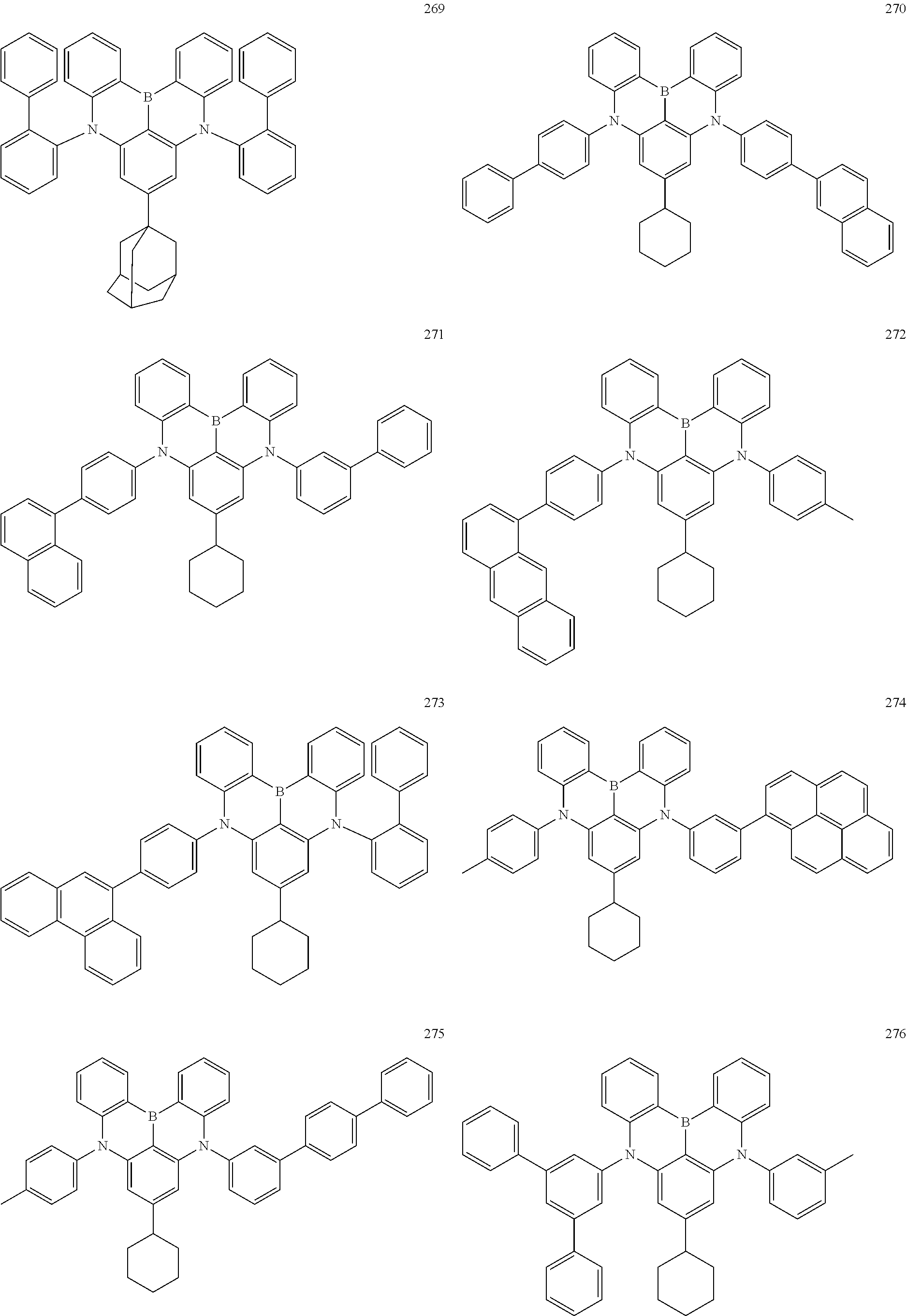







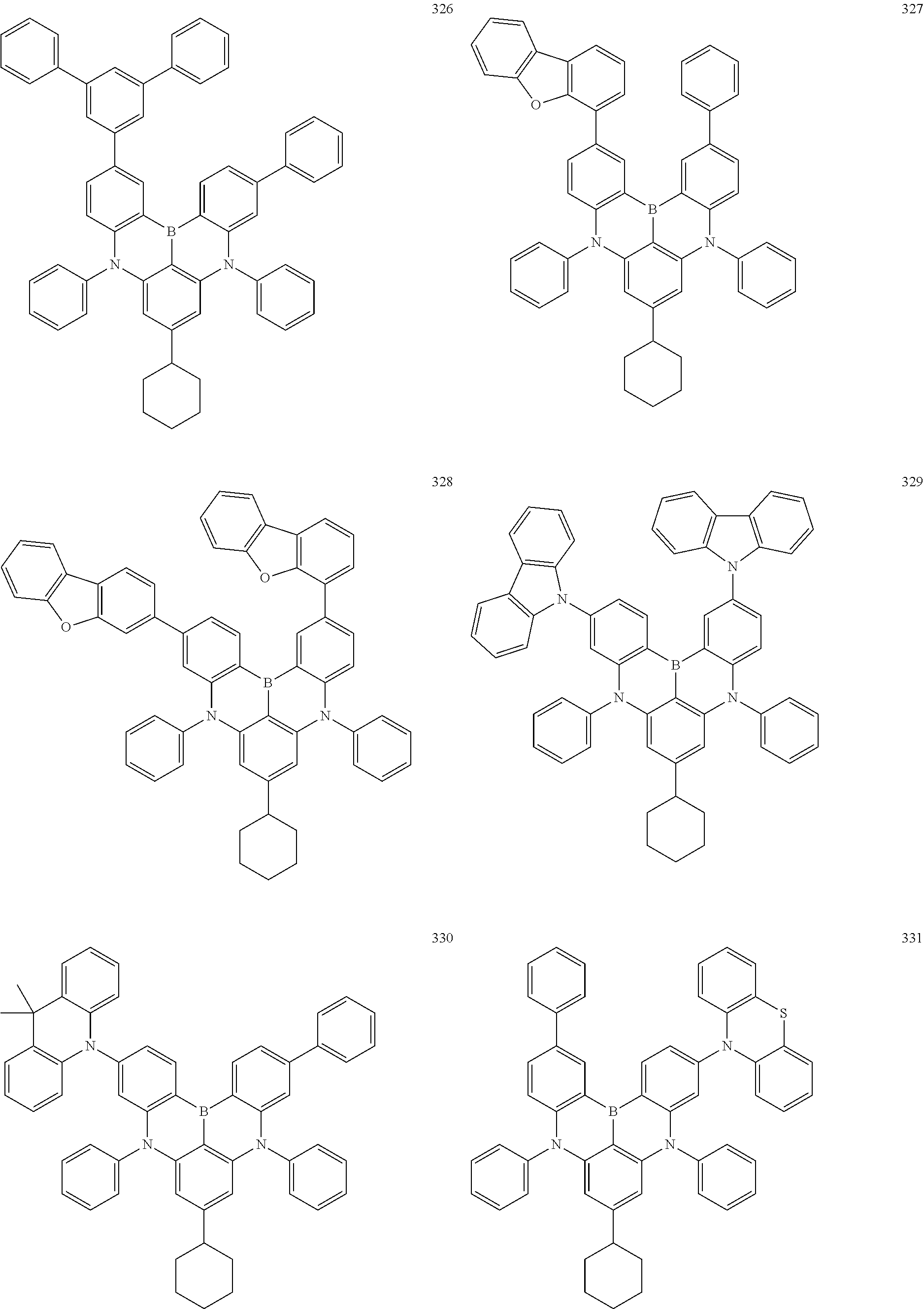










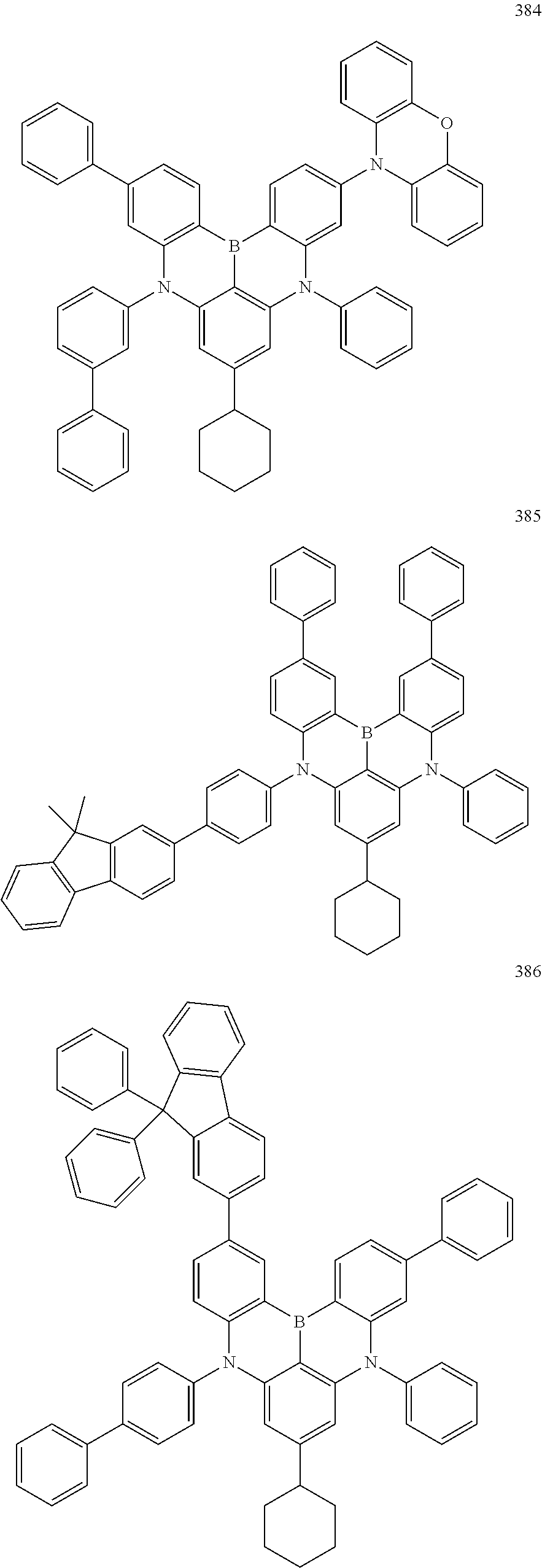





















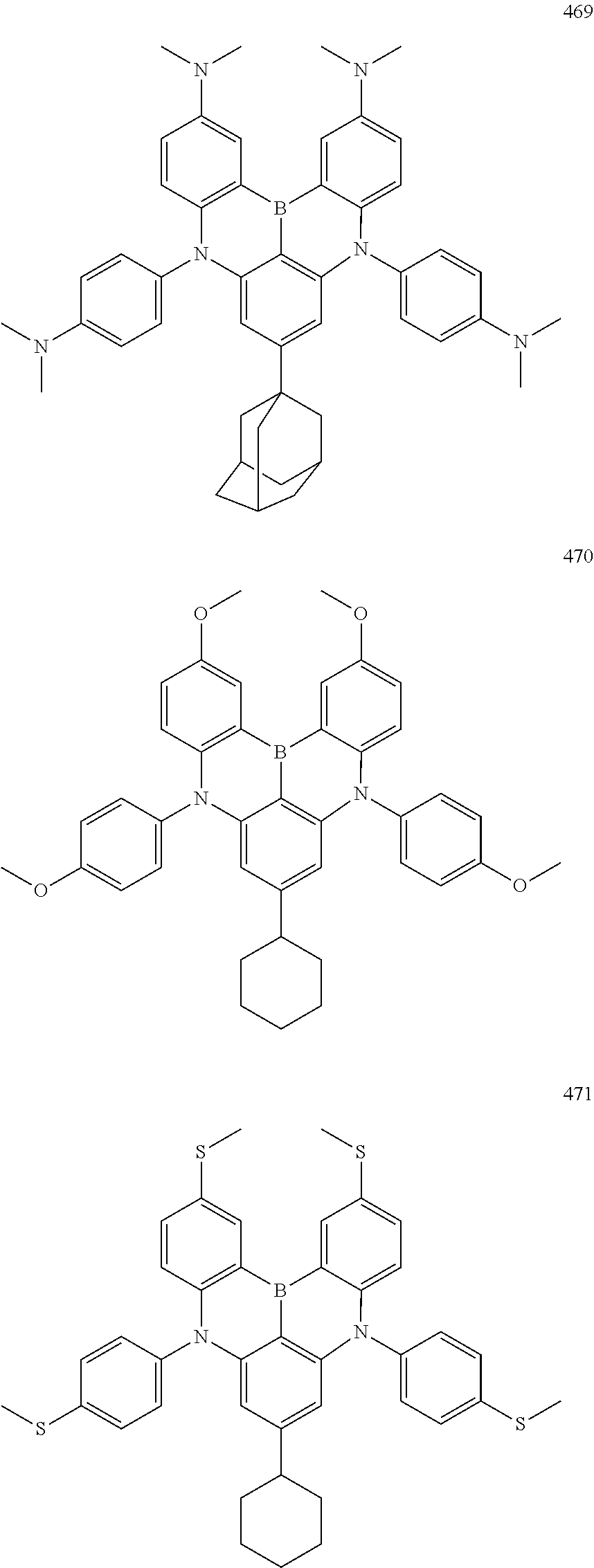




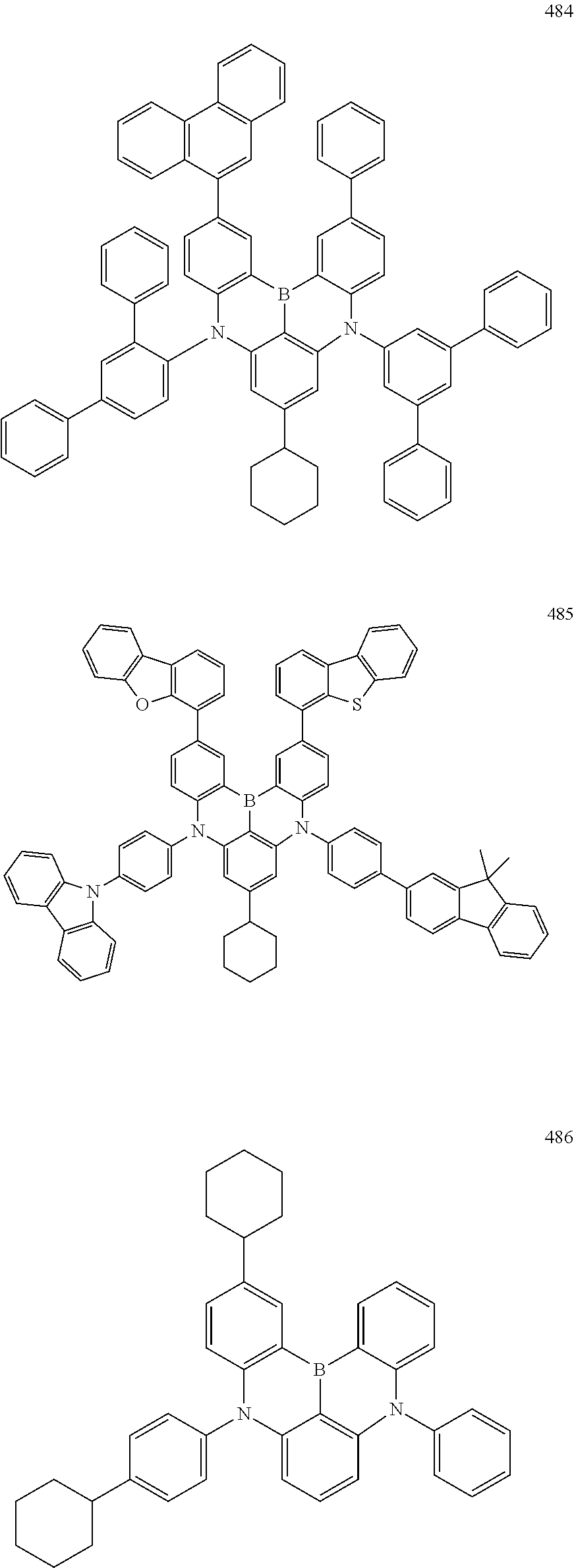











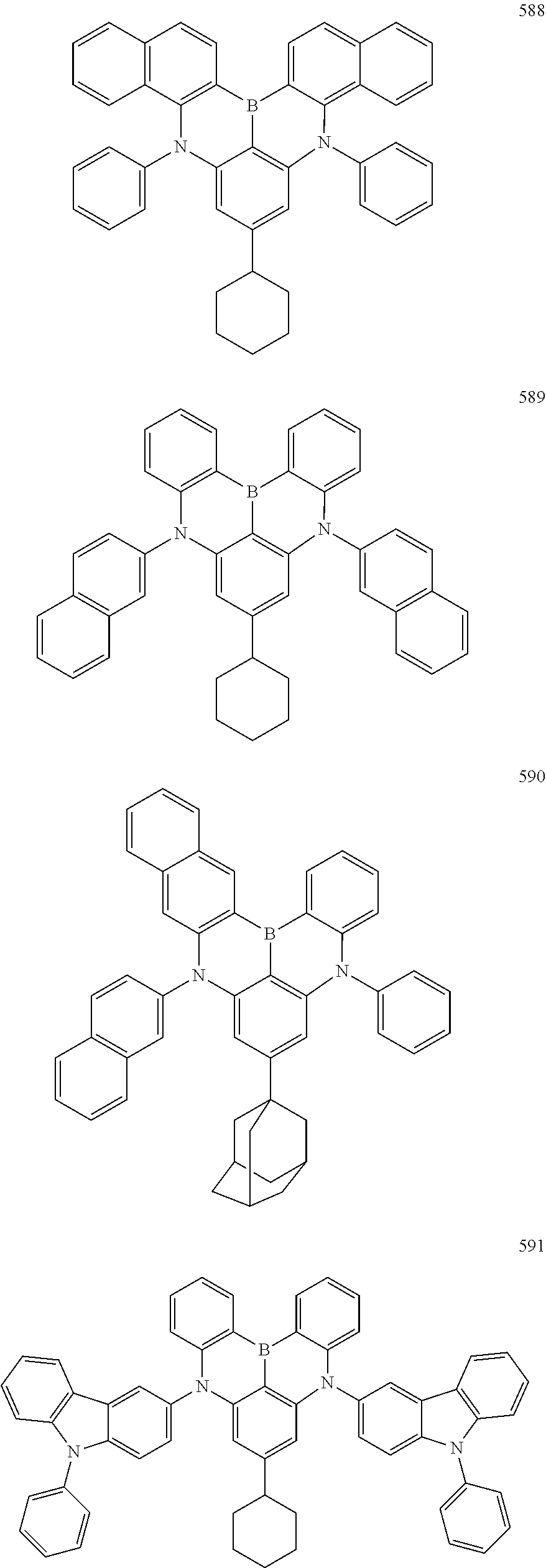









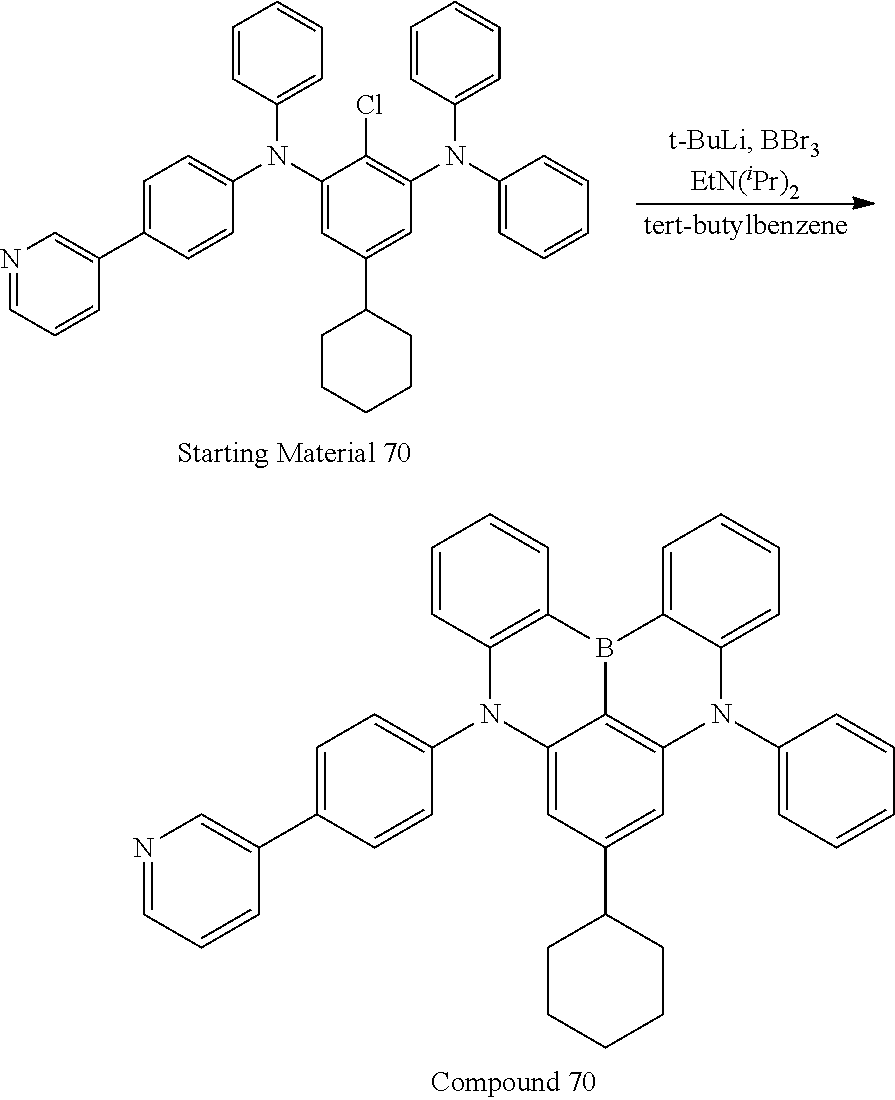






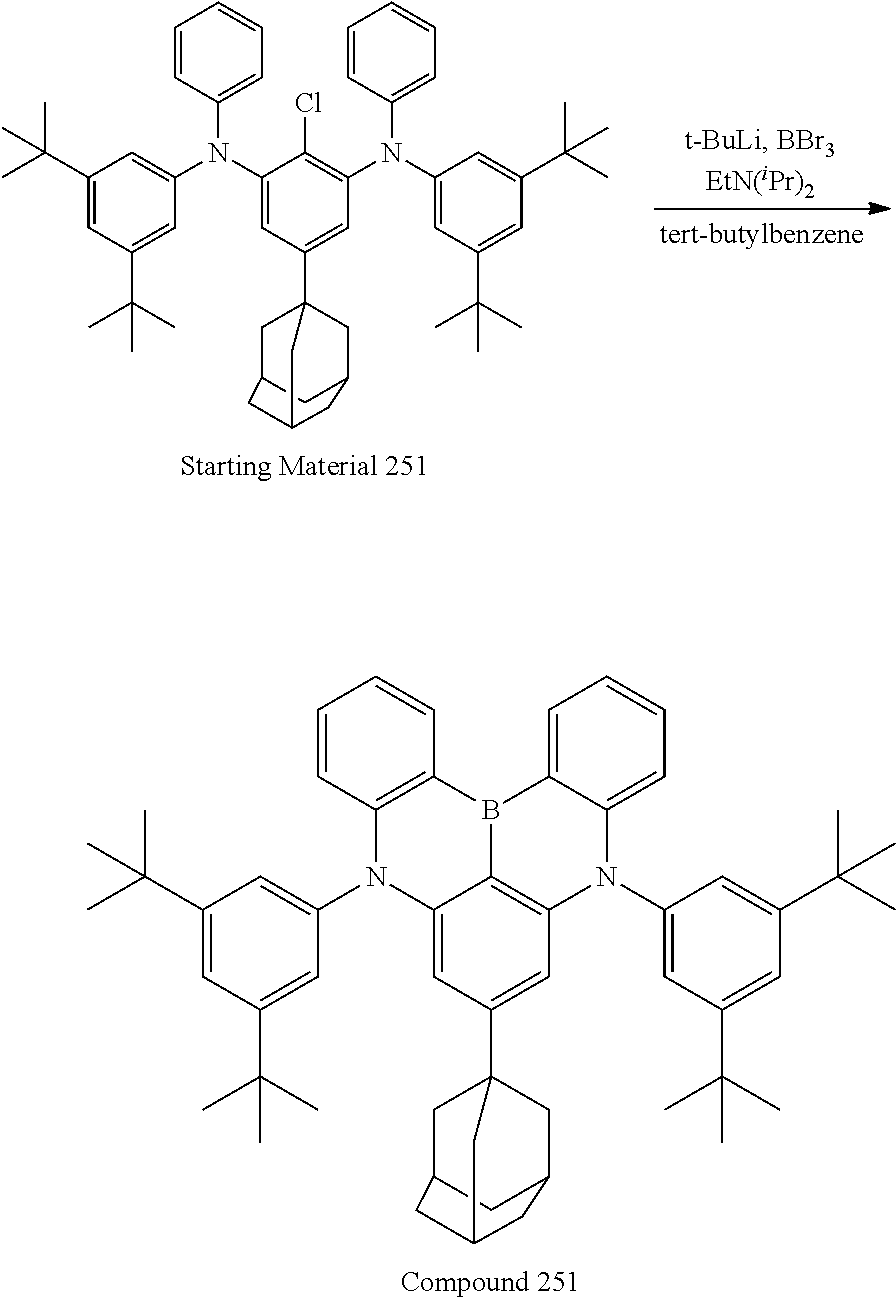







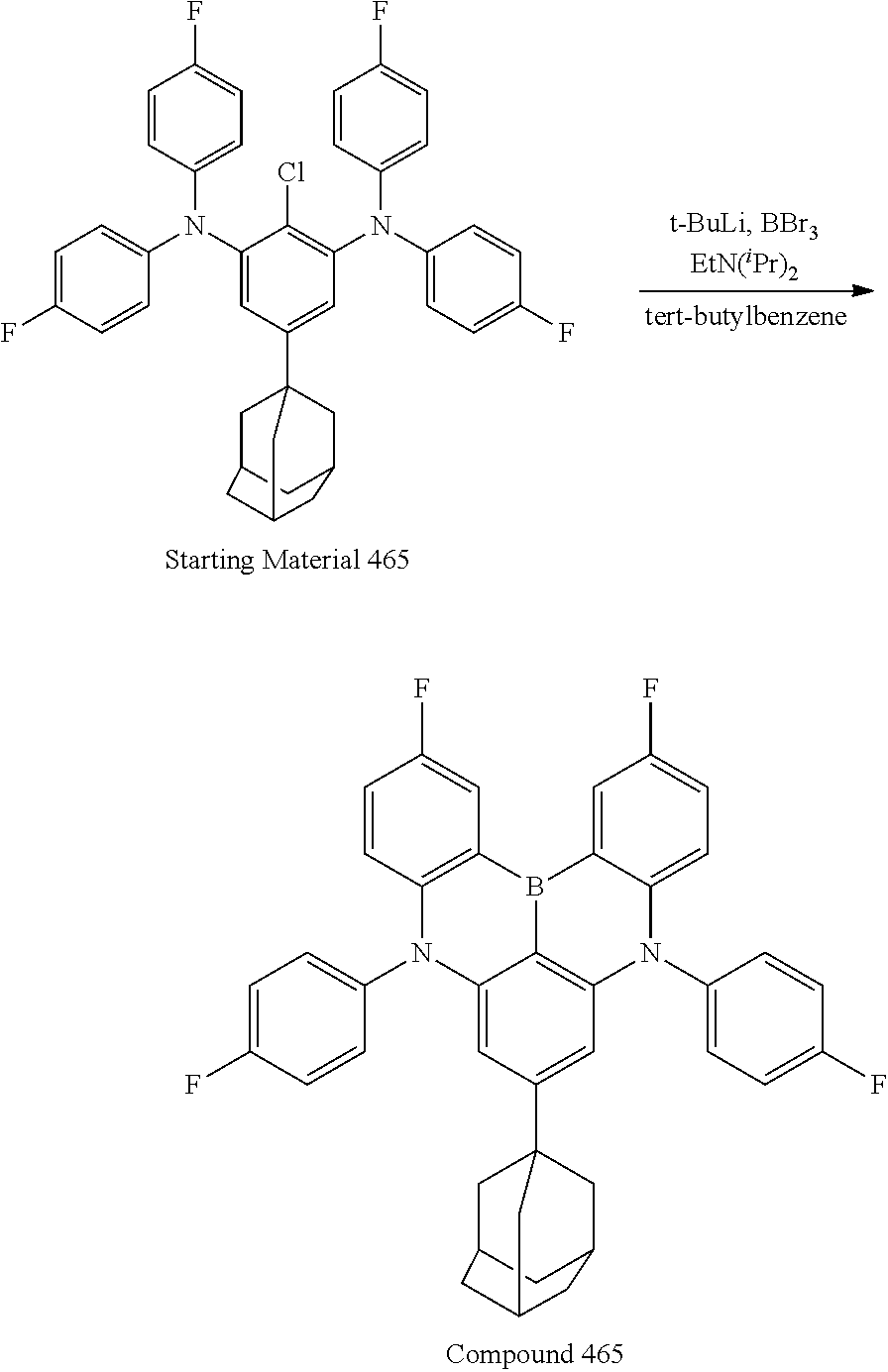




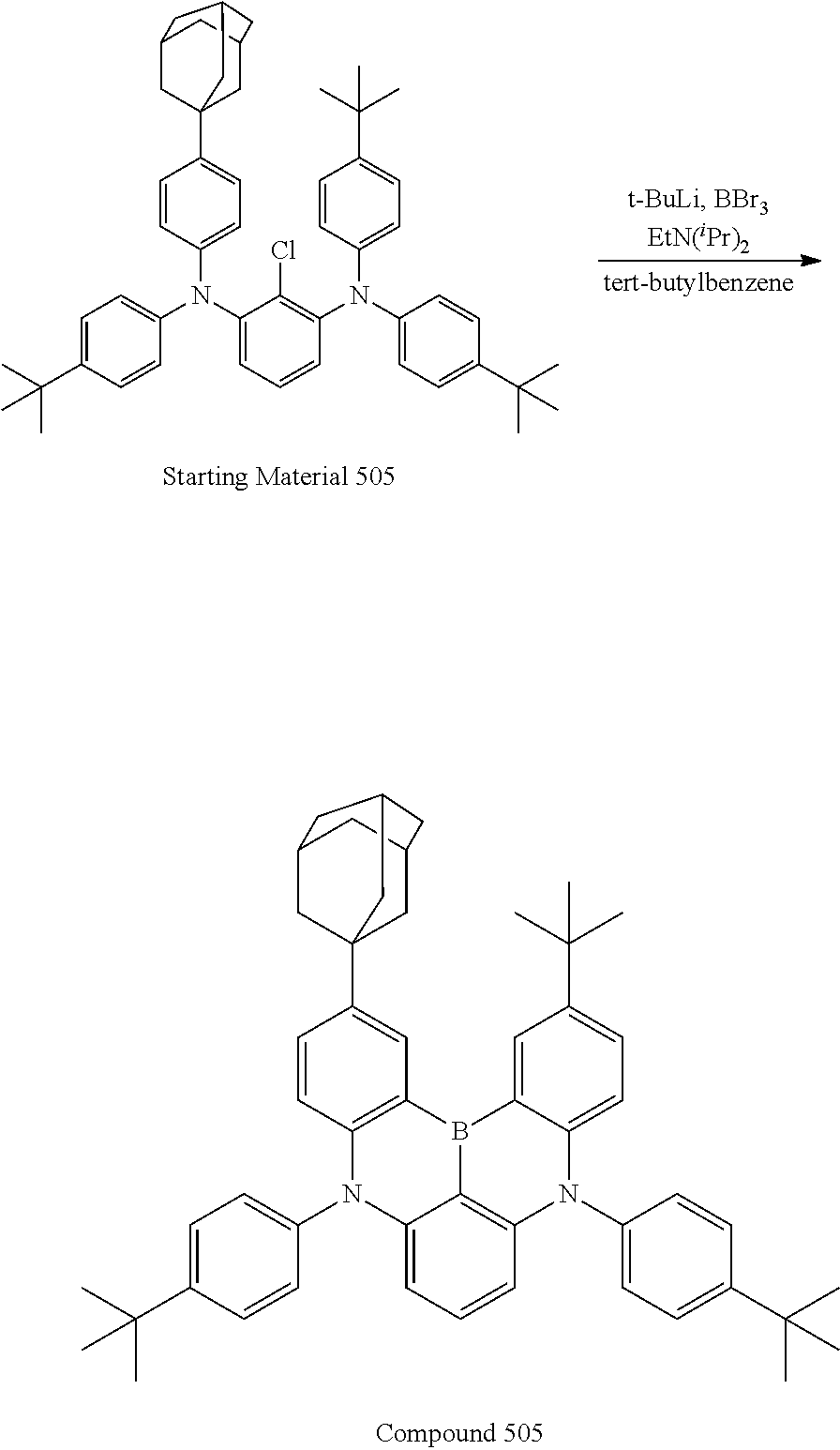










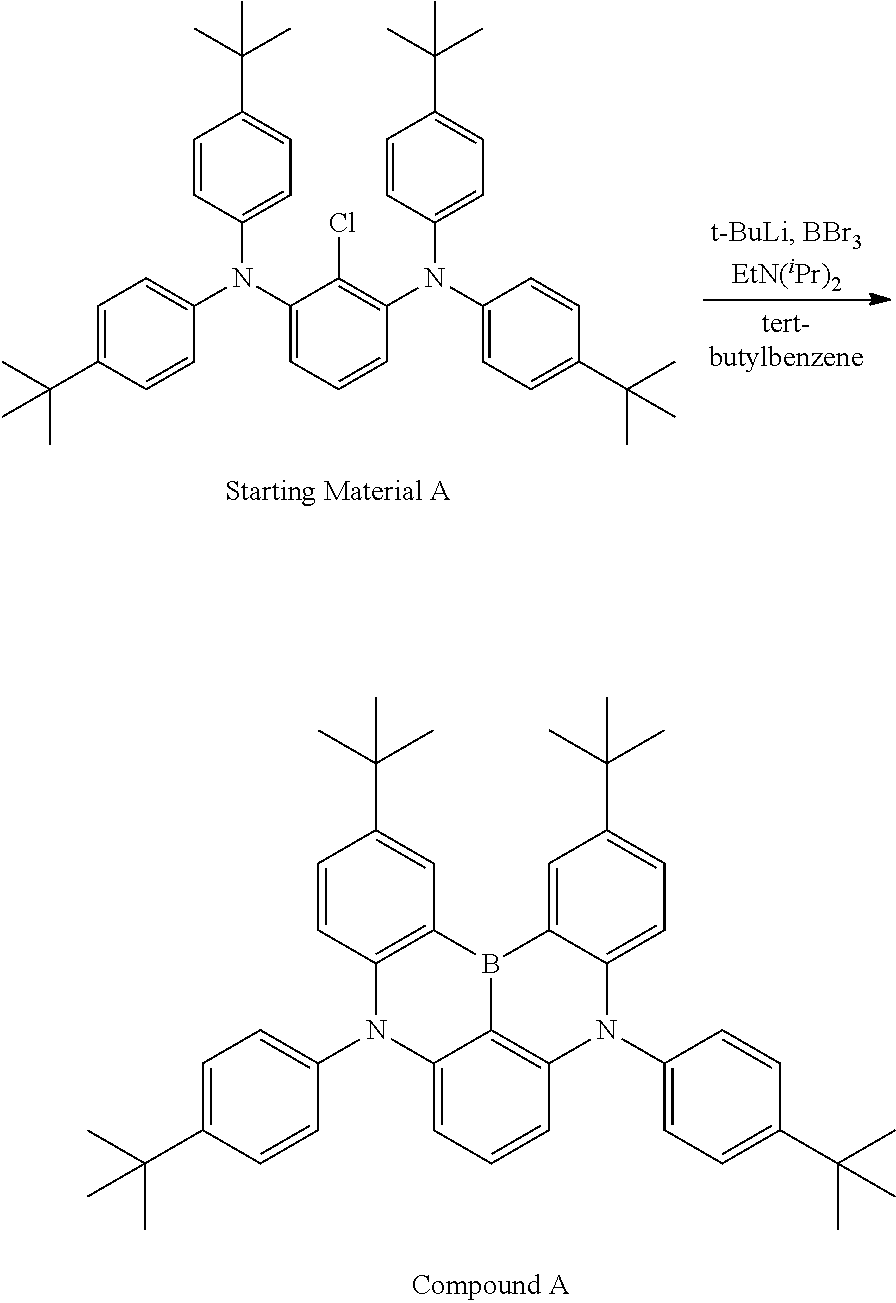


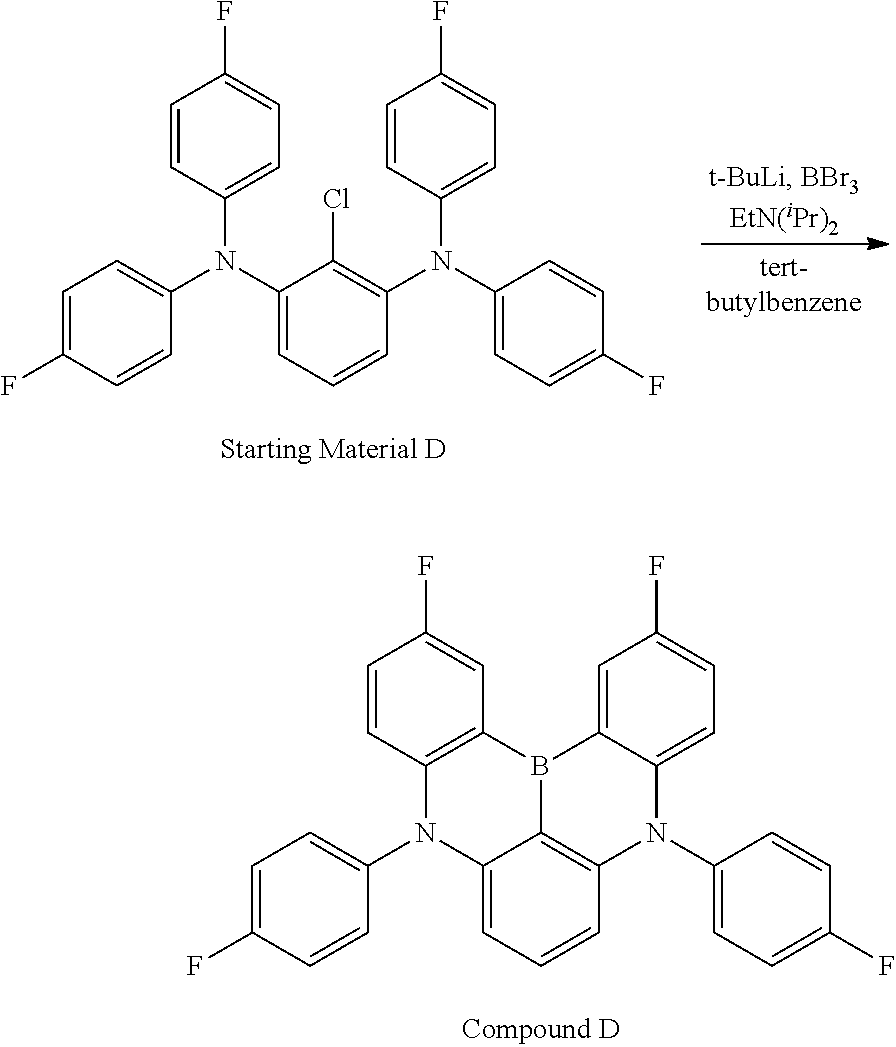




















































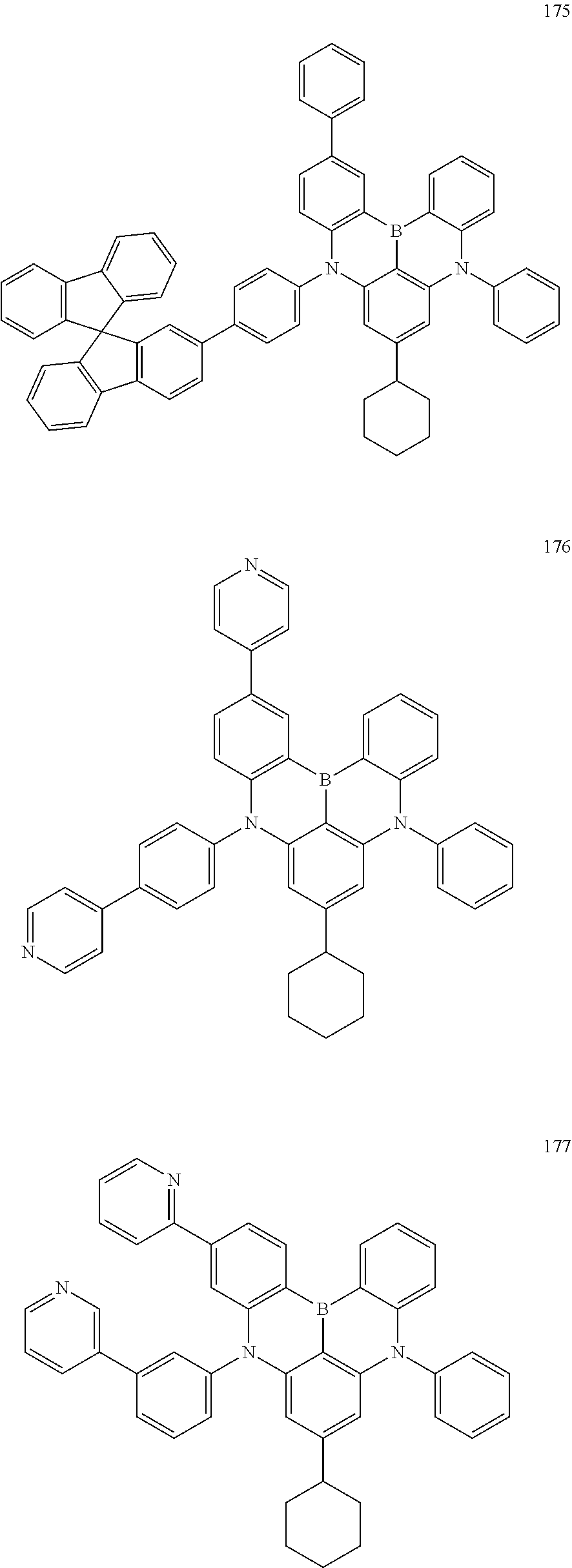









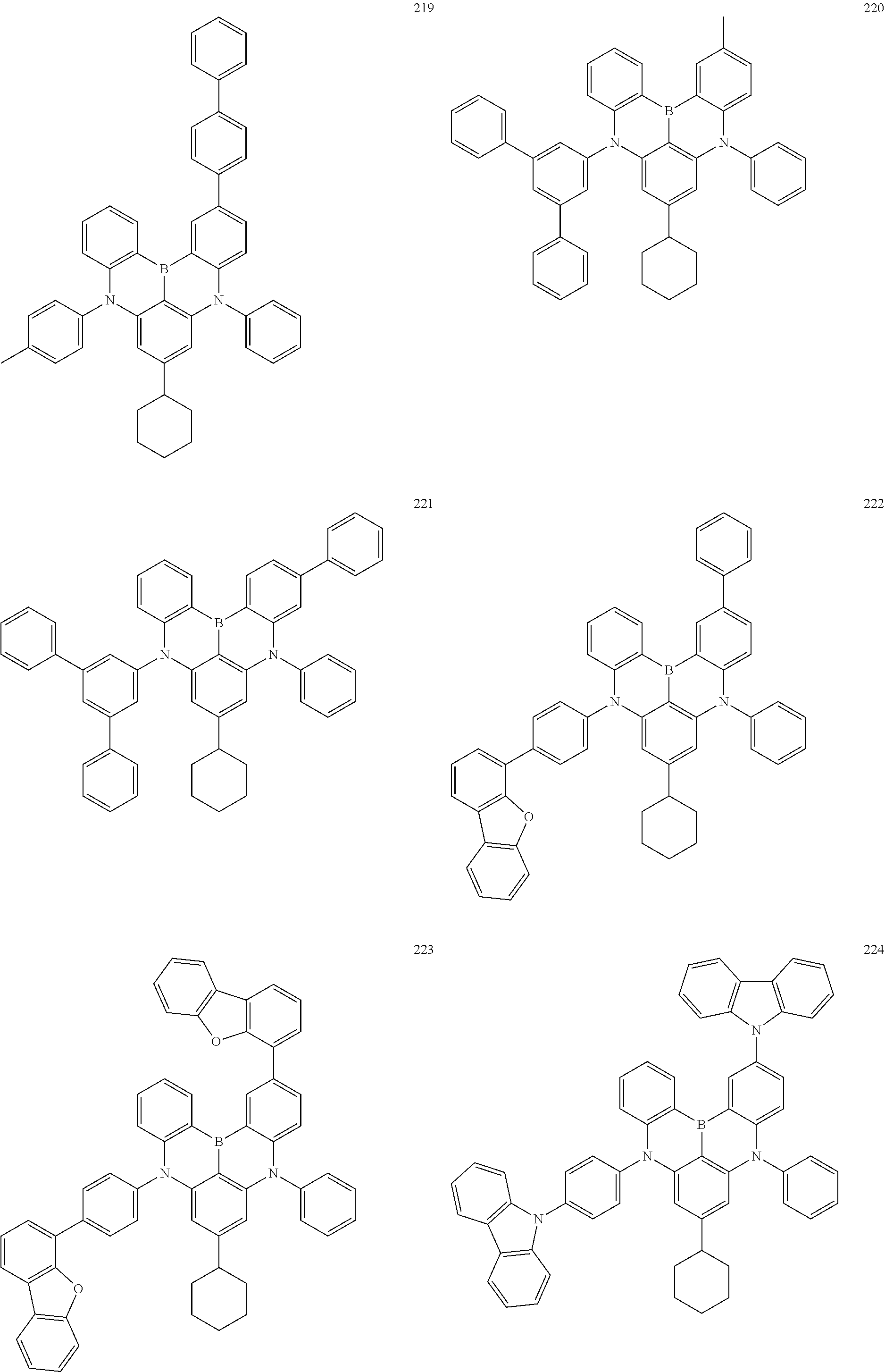





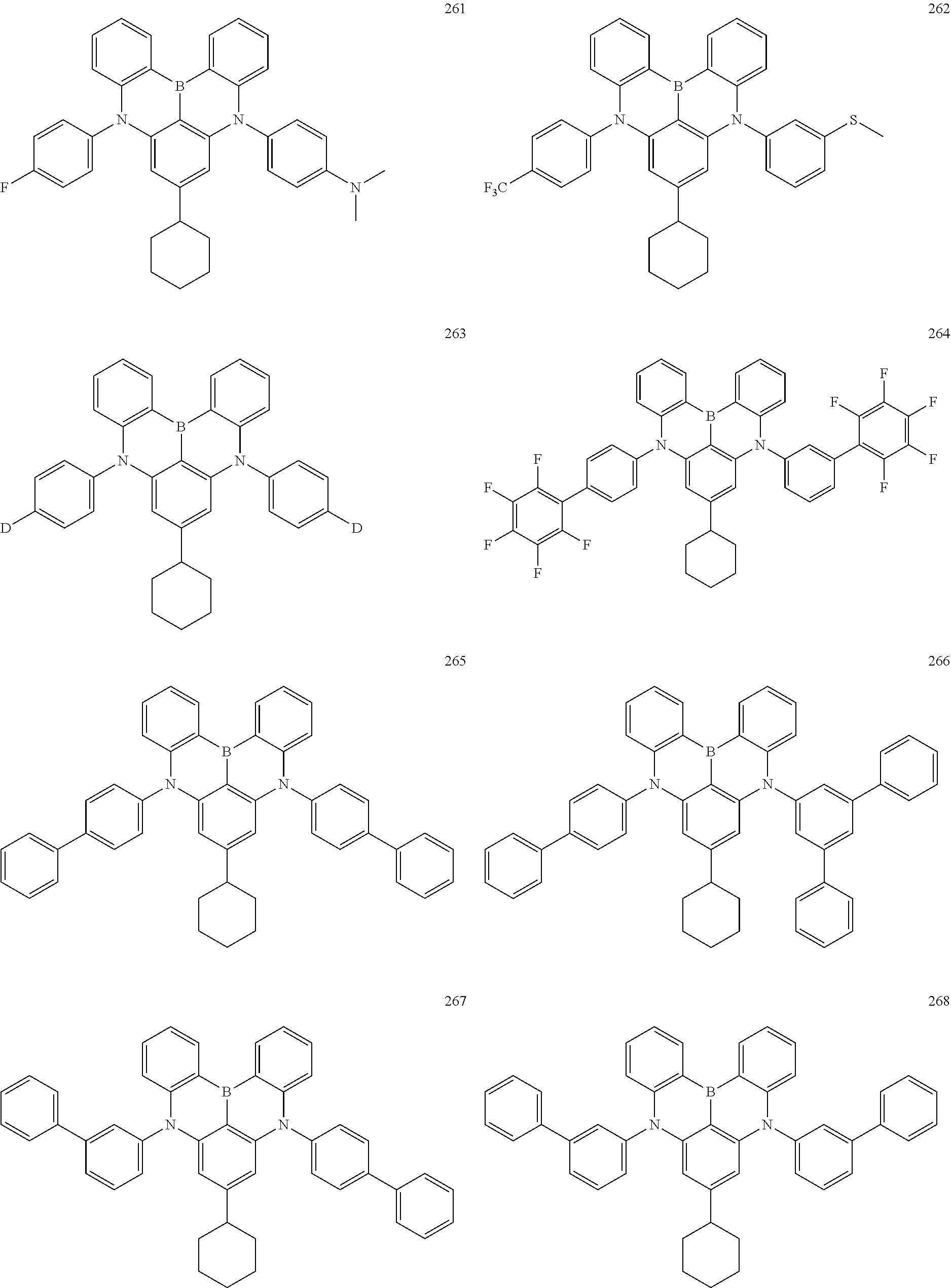


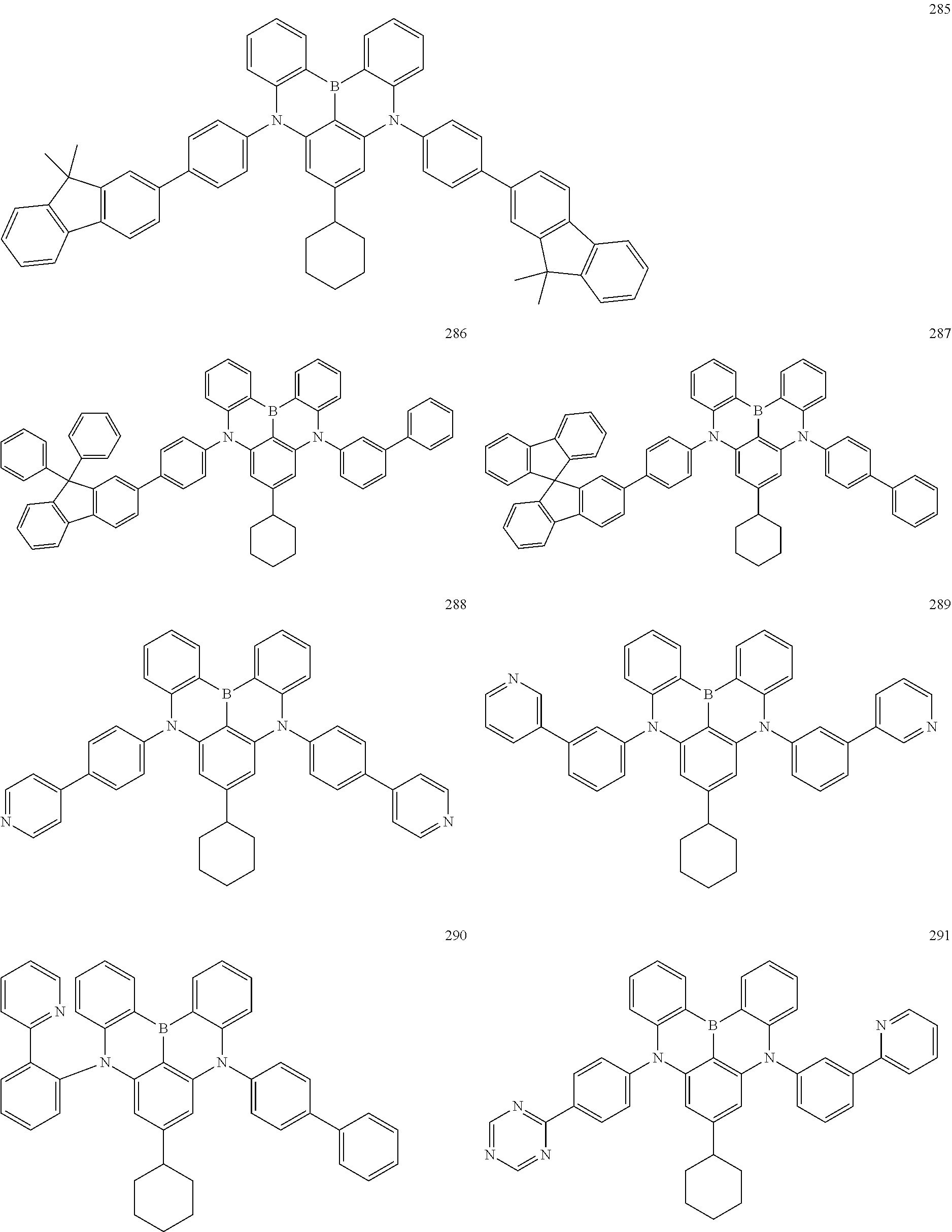

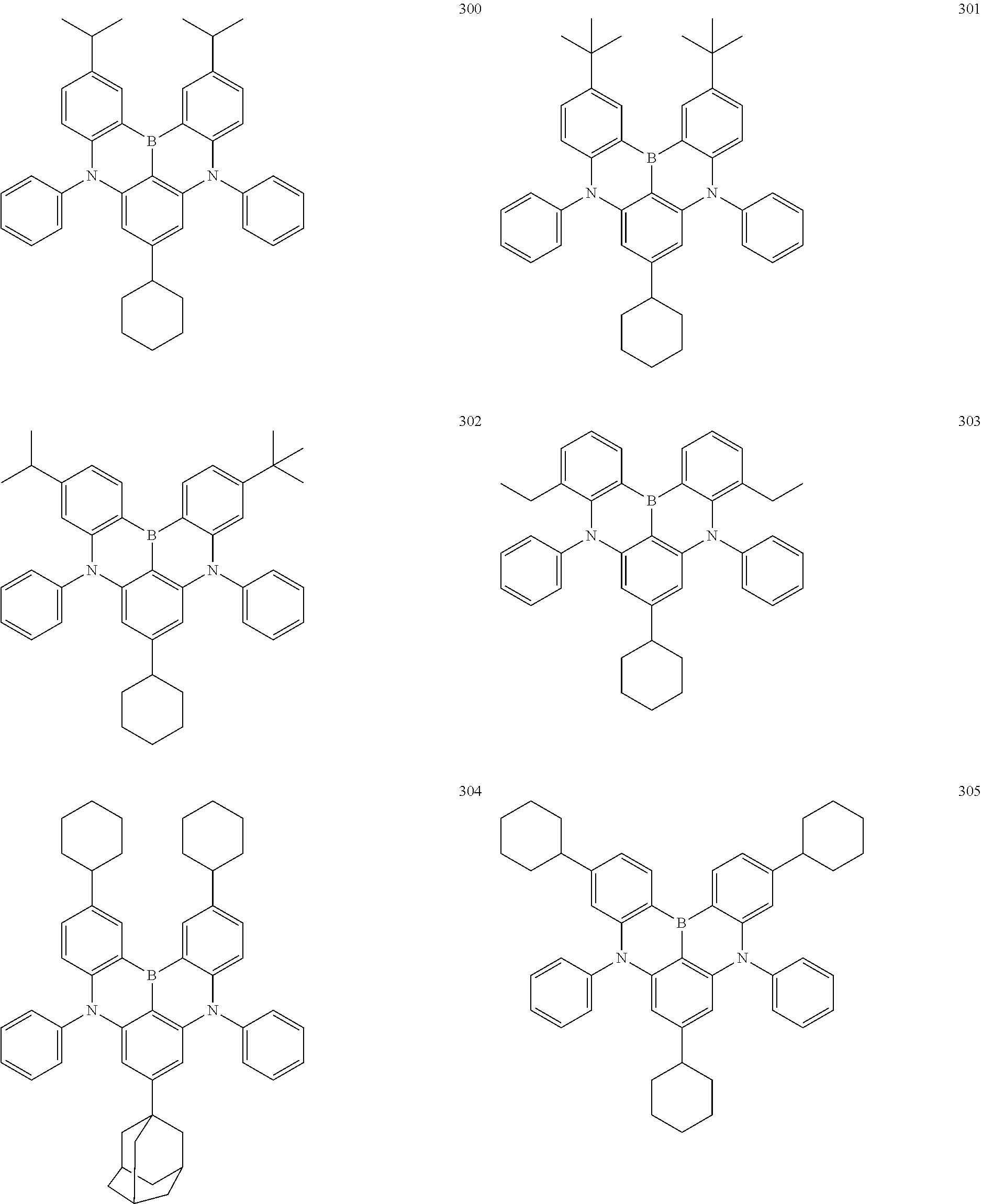
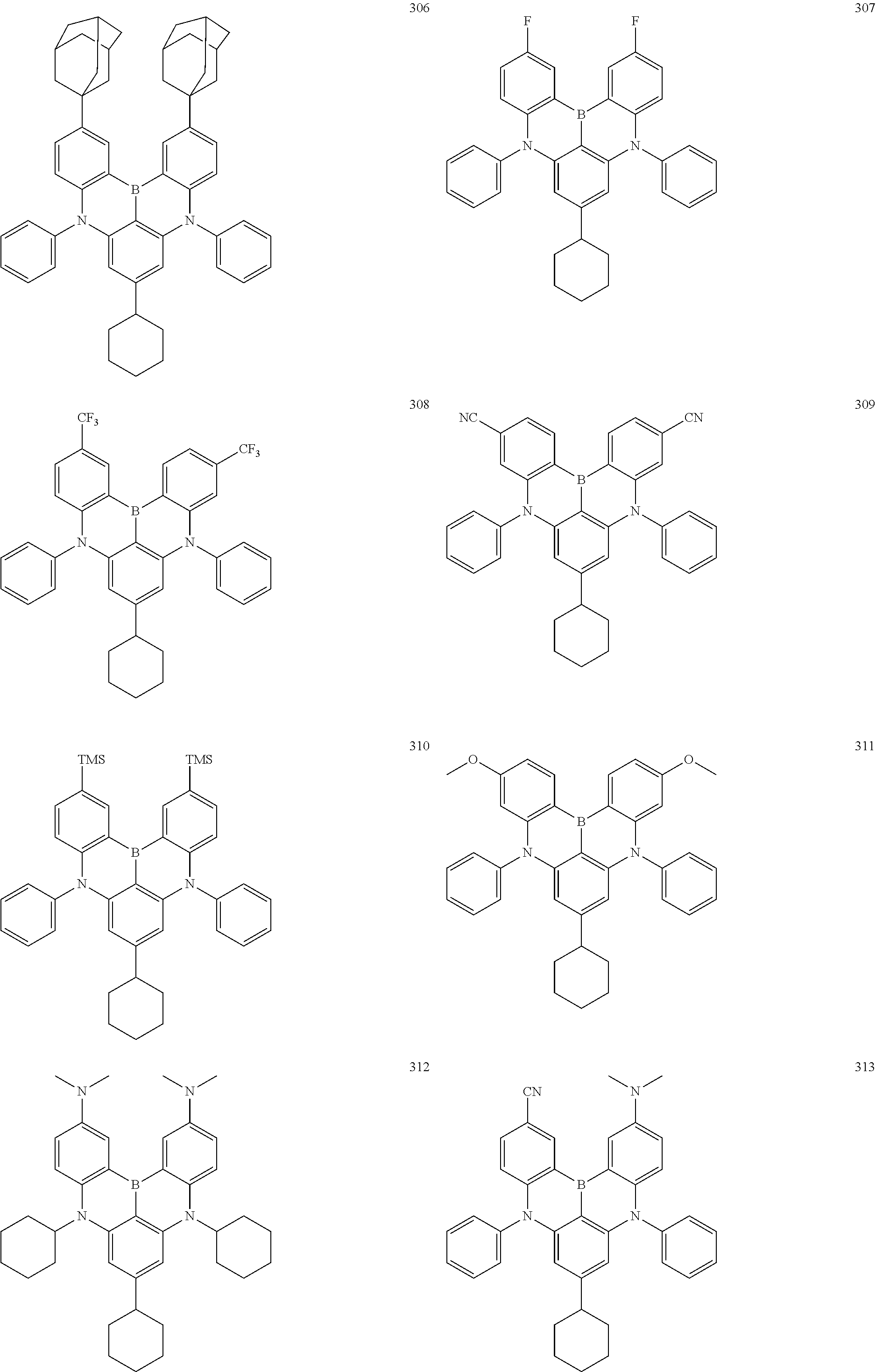
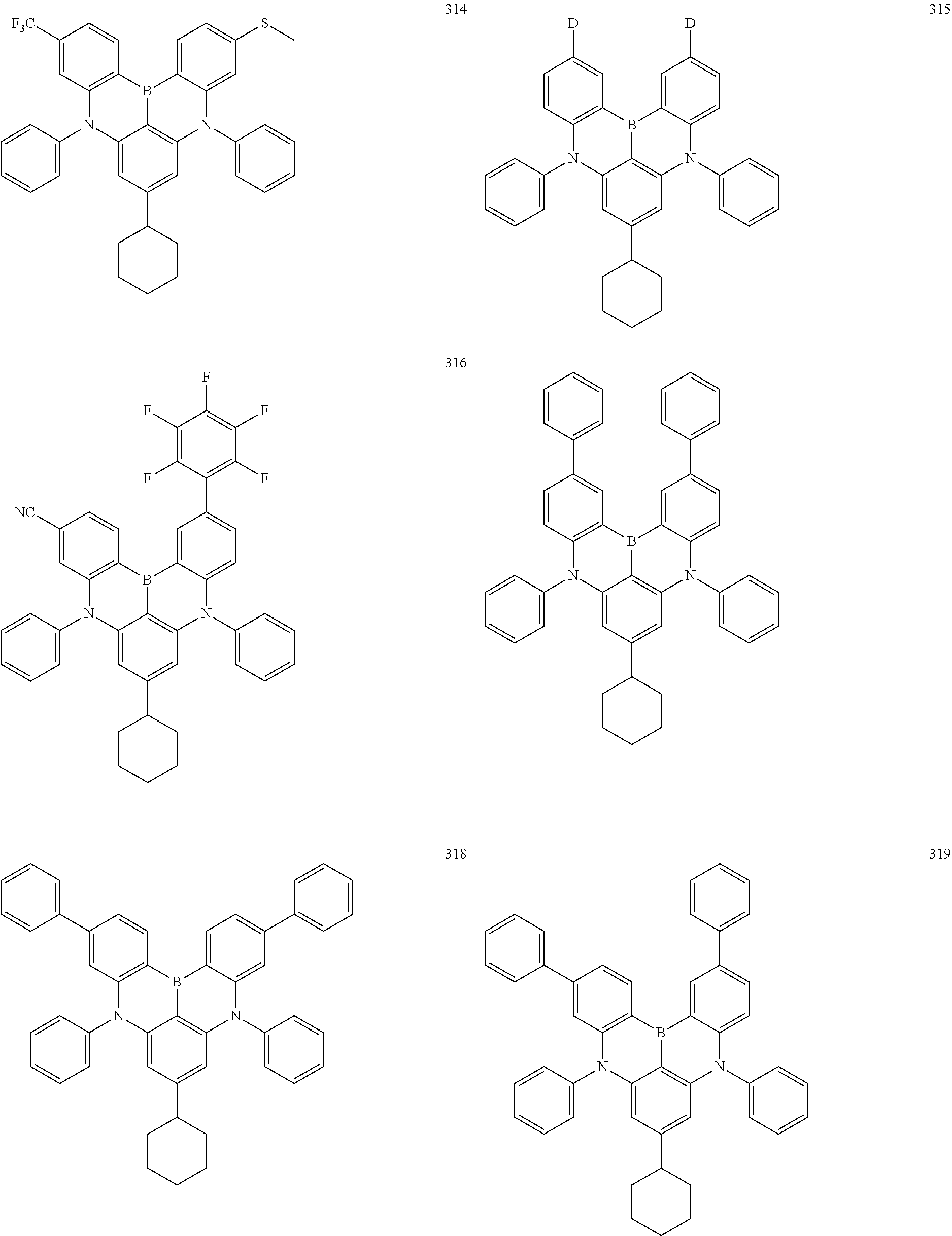





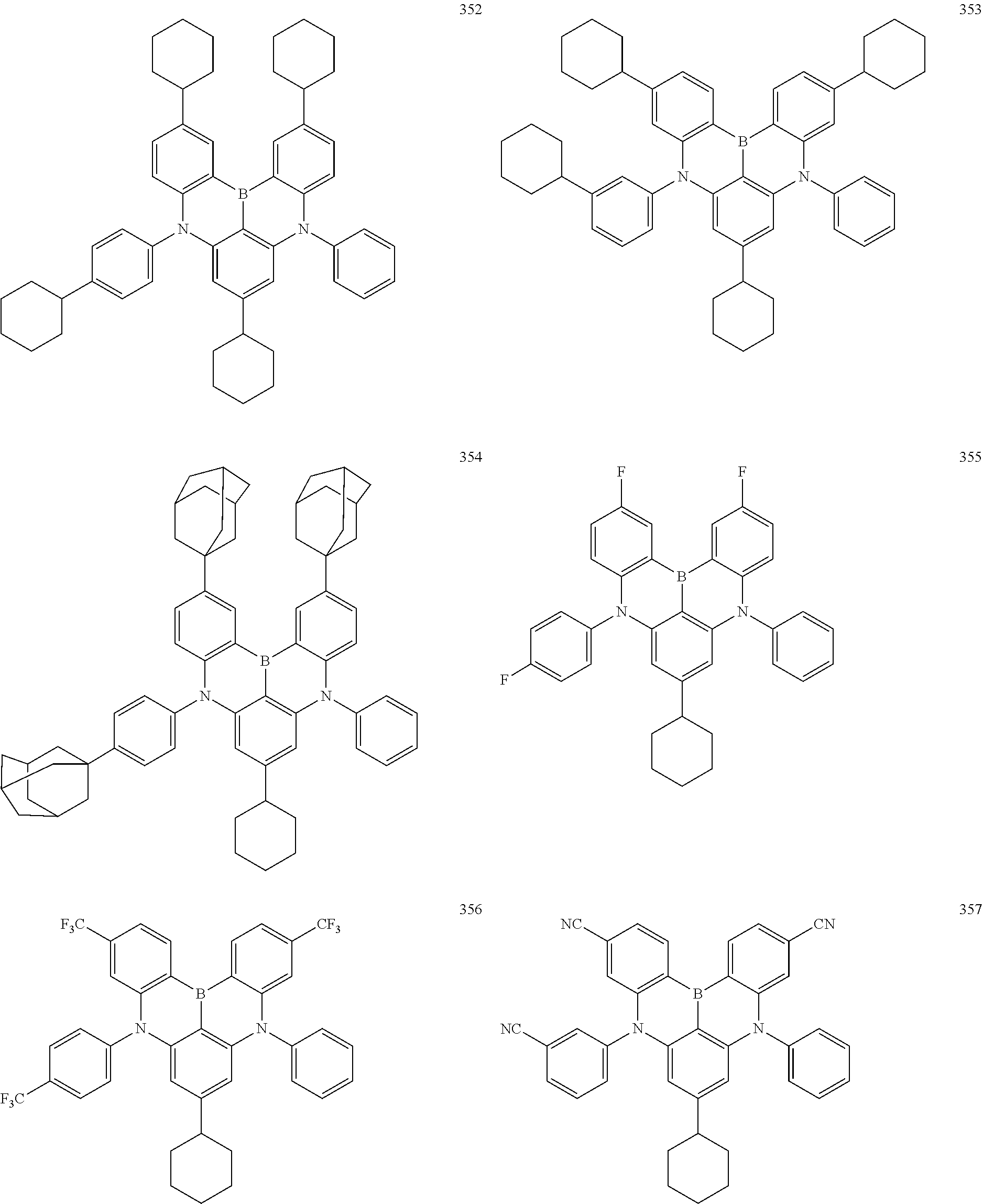







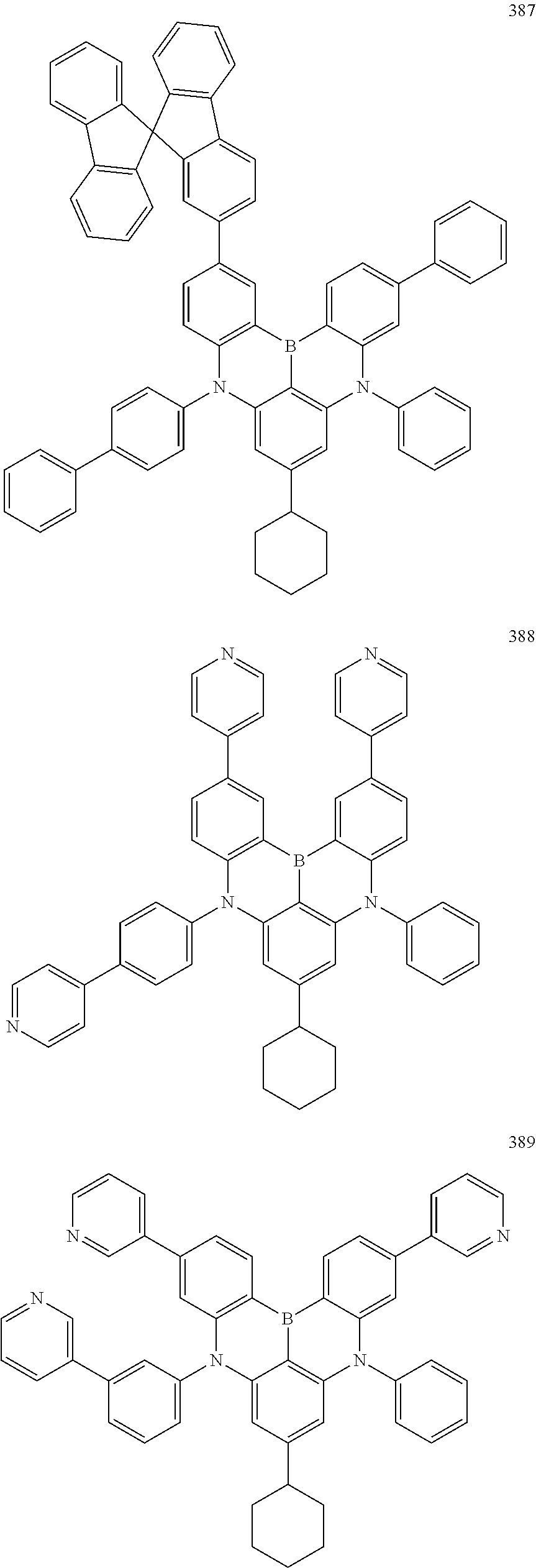





















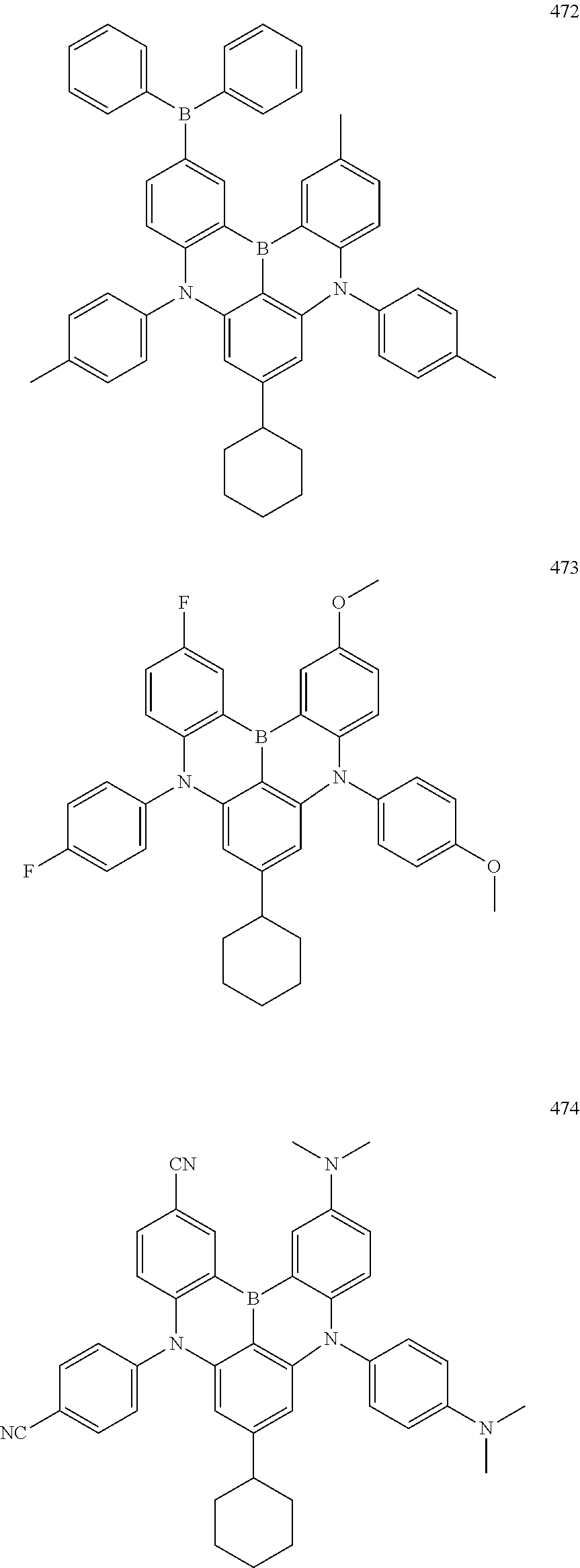


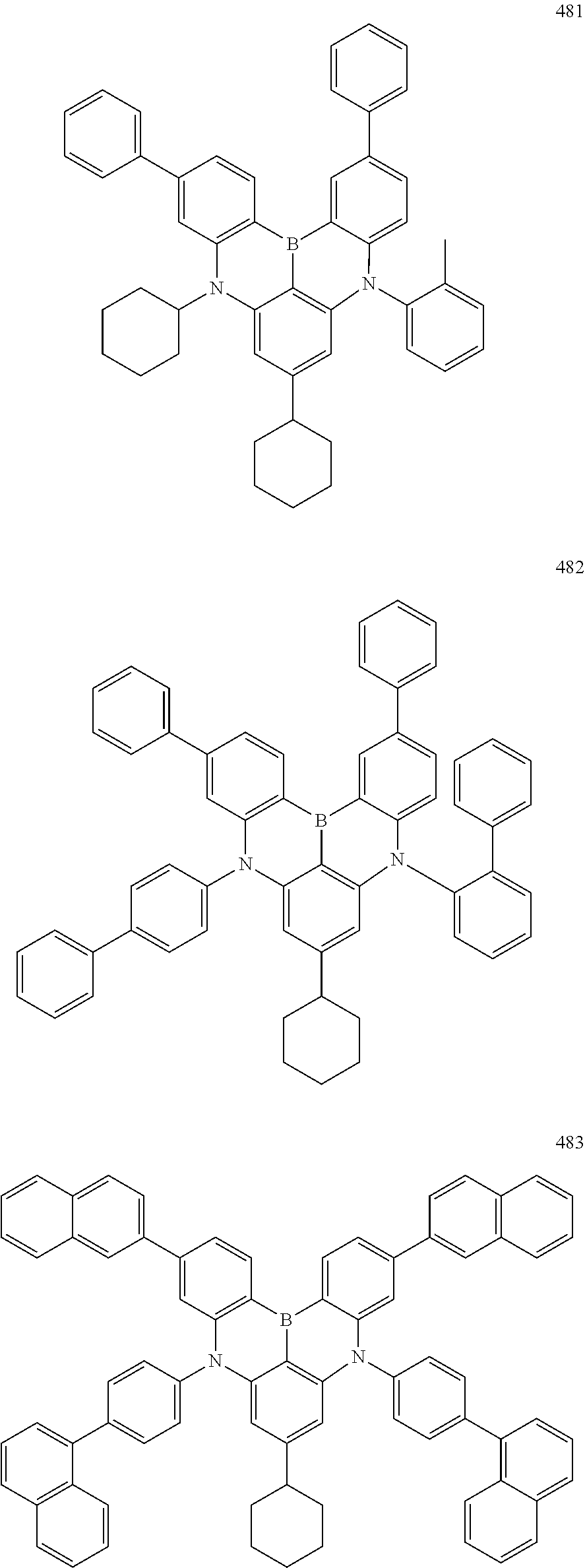





















XML
uspto.report is an independent third-party trademark research tool that is not affiliated, endorsed, or sponsored by the United States Patent and Trademark Office (USPTO) or any other governmental organization. The information provided by uspto.report is based on publicly available data at the time of writing and is intended for informational purposes only.
While we strive to provide accurate and up-to-date information, we do not guarantee the accuracy, completeness, reliability, or suitability of the information displayed on this site. The use of this site is at your own risk. Any reliance you place on such information is therefore strictly at your own risk.
All official trademark data, including owner information, should be verified by visiting the official USPTO website at www.uspto.gov. This site is not intended to replace professional legal advice and should not be used as a substitute for consulting with a legal professional who is knowledgeable about trademark law.